






















I found this woman in Chhayan Maina village where Rotary Club of Sonkatch had done several projects implemented through the Rotary Community Corps. Sarala said the toilets built by Rotary in her village were a great boon to women like her. Though not overtly effusive, the furrows on her face and the expression in her eyes said a silent ‘Thank you’ to Rotary.


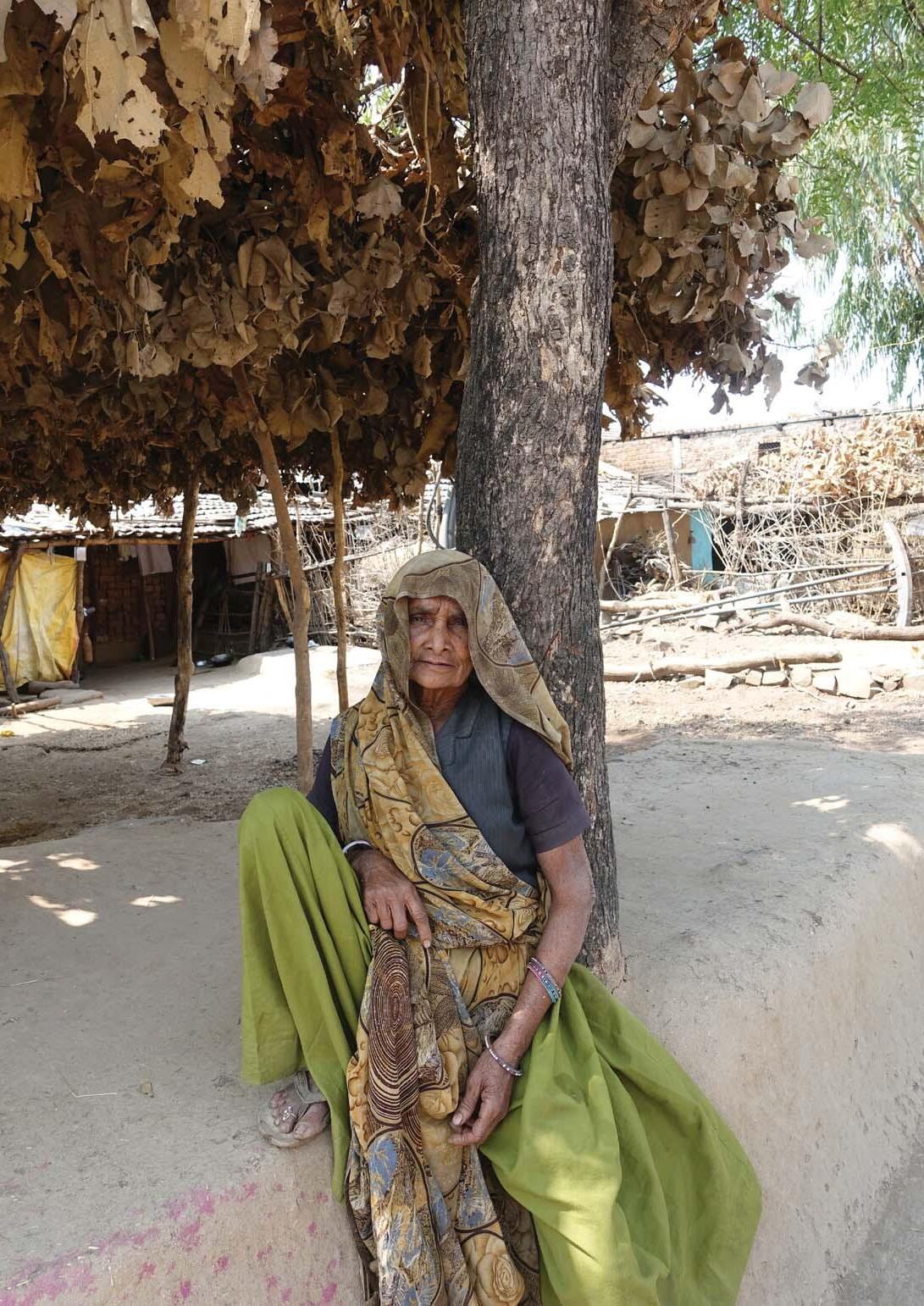

12 She wages a war against child trafficking
Meet Renutai who has taken on the mantle of saving as many girl children as she can from prostitution, and boys from child labour, in Pune.

28 Corporate membership for Rotary?
RI may soon open its doors to corporate membership, said RID C Basker at Disha, a training event for DGEs, held in Hyderabad.

46 A Rotary-Corporate bonhomie for doing good
A Rotary-CSR meet hosted by District 3190 at Bengaluru.
34 Gejha school gets new WASH facilities
RC Delhi Ashoka enhances sanitation facilities in a government school with global grants.
36 A virtual science lab
PRIP Kalyan Banerjee inaugurates a virtual science lab set up in a school by RC Jalna Midtown.
39 And now a Rotary club for the differently-abled
Physical disability is not a barrier for these new members for doing good in the world.

50 Rotary Moodbidri celebrates 50 years
Rotary’s reach has made a big difference in this quaint little town.
70 Light up your immune system
Discover how healing words uttered daily transform the mental attitude and physical wellbeing.

42 Vignettes of Varanasi
Pictures of the pilgrimage town from the coffee-table book brought out by RC Benaras.
On the cover: Renutai, a crusader against child trafficking and prostitution, in Pune.
Picture by: Rasheeda Bhagat


Iwas thrilled to see the front cover of the March issue showing nature’s beauty with green paddy fields of Kerala and a lot of white birds with the caption Greening Kerala. Rotary International President Ian H S Riseley’s suggestion to all Rotary clubs to sponsor at least one Rotaract club and utilise the energy of young Rotaractors in service projects, while letting them know that the Rotary clubs and Rotarians are waiting anxiously to welcome them into the Rotary fold, is an eye-opener to all club leaders. The full coverage of the pathbreaking project REAP by the Editor is fantastic as it describes well the pains taken by DG Suresh Mathew and his dedicated team members.
Congratulations to all associated with this painstaking project. I am truly proud to be a D 3211 Rotarian.
M T Philip RC Trivandrum Suburban — D 3211
Rotary must slash PR costs Community service is the backbone of Rotary and plays a vital role in enhancing its public image. Rotary’s PolioPlus and polio eradication programmes have immensely enhanced the image of Rotarians across the world and even the Bill and Melinda Gates Foundation is investing hugely in the polio initiative.
This should help us understand that our service helps us get donations and it’s our job as Rotarians to fulfil the expectations of the world. Hence our programmes and events must reflect simplicity. The PR spending of Rotary International to enhance its public image is 2–3 per cent. I urge Rotary clubs to bring down their PR costs and instead of focusing on grand events, simply focus on our community projects.
Mahendra Dhakad RC Mandsaur — D 3040
Thearticle Wash or Wipe? is an excellent eye-opener for Indians trying to adopt all Western practices. This write-up should be published in The Rotarian too. I congratulate the writer Rakesh Bhatia for the article.
Sujata Srinivasan RC Cuddalore Central — D 2981
Heroic women of Kovai
Drivinga car to reach London from Coimbatore covering a distance of 26,800 km, traversing 24 countries having different terrains by three heroic ladies, is really an adventure to be appreciated. Even for a formal visit to the US and Canada to see our children living there, we have to endure many hurdles on the way.
But these heroic ladies have proved to have the mettle of astronauts by achieving their goal successfully. We salute Meenakshi Arvind, Mookambiga Rathinam and Priya Rajpal and other good-hearted people in their heroic achievement.
P Iyyapparajan, RC Theni — D 3000
Excellent Editorial
Congrats on the excellent Editorial on integrity. The write-up is superb as every sentence is written with deep reflection giving a strong message. We Rotarians do a lot of good work and today the world is a better place because of us. Yes, our membership strength is minuscule compared to India’s population, but this small population of Rotarians should be able to impress and influence various sections of society, including politics, on the kind of values that Rotary asks us to imbibe. But most of us are sitting in our comfort zones and are thus taken for a ride. True we cannot change things overnight but we have been quiet for too long. The values of life have been diluted and the chalta hai attitude has engulfed many of us.
Former President APJ Abdul Kalam was always asking one question at every school and college he addressed: “How many of you would like to join politics?” and hardly few hands went up each time. That is because politics has become an anathema to society at large and because of this we have daylight robberies of thousands of crores.
Forget protesting, we don’t even raise our voice; the greatest sin of modern world is apathy.
Robert F Rego, RC Bajpe — D 3181
Thethought-provoking Editorial on the various scams perpetrated on India by some unscrupulous businessmen cautions Rotarians on the need to keep their integrity and honour intact and uphold good values with self-restraint and discipline.
Once in Rotary, these big industrialists would be transformed because Rotary has the touchstone of a 4-Way Test. But the irony is that we can’t make everybody Rotarians.
Can I envision a world where the message of Rotary will spread to
every individual so that it can be free from corruption and a better place to live in.
Arun Kumar Dash RC Baripada — D 3262
Parrot speak
Iama non-Rotarian from Erode in Tami Nadu and a regular reader of your magazine. I liked the article Ask the Parrot by Jaishree as vocations like parrot astrology give some income to needy people. In Club Matters, it is to be appreciated that medical insurance policies were issued for the differently-abled by RC Tirupur Knit City, D 3202. Kudos to all the donors. Sampath Kumar, Erode
A realistic vision
The article What millennials want... sketches a realistic vision with future plan. The transcript with facts and figures has touched our mind. It rightly points out that our mission is to reduce unemployment and social conflict. The implication of this cause can be seen recently in our social and political scenario. My compliments to RI General Secretary John Hewko. Soumitra Chakraborty RC Tollygunge — D 3291
Thank you
Thank you Rasheeda Bhagat for writing about St Jude in A helping hand in such a warm and humane manner. We are truly grateful to the various Rotary clubs who have been supporting St Jude in a sustained manner.
Usha Banerji, non-Rotarian
A motivating story
The article Where Rotary is more than a preferred partner turns the
Rotary News is one of the most awaited magazines in the digital world. Rarely it happens that praises continue month after month, but your team deserves it. PRIP Rajendra Saboo and his spouse Usha Saboo deserve praise for their outstanding work in the medical missions. Further, extravaganza in Rotary meetings is needed for PR but it’s now becoming ostentatious and hence needs to be controlled. Some norms should be laid down and from the membership dues only 40 per cent should be spent on food, fun and beverage at the district and club levels.
The coverage of two great cricketers Yuvraj Singh and Zaheer Khan (Feb issue) was
spotlight on a convincing step for improvement of rural Maharashtra. Also, it made me feel good as a Rotarian of RC Pune Magarpatta City where I was part of the team that gave a few kits to the Zilla Parishad schools in Magarpatta. Such articles will energise more Rotarians to get connected with this activity.
Milind Shinde, RC Pune Magarpatta City — D 3131
Imust congratulate the Editorial team for the December issue with prime focus on the Northeast and RI District 3240. It was a long-awaited step taken by you. We the Rotarians
needed as their contributions are worth a recall. Rotary’s Young Turk was another refreshing story and it’s a fact that a club not growing will die. The two projects Wheels to ease disability (RC Dharapuram, D 3240) and A school comes alive (RC Siliguri Central, D 3240) are projects which spread the Rotary message and really benefit the needy ones.
The LBW articles by TCA Srinivasa Raghavan as usual are thought-provoking.
In brief is a welcome addition. I congratulate the Editorial team for making the magazine the most awaited magazine for my entire family. Aadesh Sikchi, RC Navi Mumbai — D 3142
of D 3240 were overjoyed to see one of district events adorning the cover page of our prestigious magazine. We are blessed by nature in abundance in D 3240 and the sense of fellowship is remarkable among the Rotarians of the nine states in the district.
I must also congratulate the Rotarians of D 3282 for their immense love for Rotary and the exemplary level of participation in the multidistrict meet at Agartala aptly named Setubandhan . You have proved that good work from any part of the country will get equal weightage in Rotary News . Dr Prosenjit Ghosh, RC Green Land Silchar — D 3240
We welcome your feedback. Write to the Editor: rotarynews@rosaonline.org; rushbhagat@gmail.com
RI Dist 2981 DG P S Ramesh Babu
RI Dist 2982 DG Dharmesh R Patel
RI Dist 3000 DG P Gopalakrishnan
RI Dist 3011 DG Ravi Choudhary
RI Dist 3012 DG Sattish Singhal
RI Dist 3020 DG G V Rama Rao
RI Dist 3030 DG Dr K Sunder Rajan
RI Dist 3040 DG Dr Zamin Hussain
RI Dist 3053 DG Rajkumar Bhutoria
RI Dist 3054 DG Maullin Manubhai Patel
RI Dist 3060 DG Ruchir Anirudh Jani
RI Dist 3070 DG Parvinder Jit Singh
RI Dist 3080 DG T K Ruby
RI Dist 3090 DG Bagh Singh Pannu
RI Dist 3110 DG Vinay Kumar Asthana
RI Dist 3120 DG Ranjeet Singh
RI Dist 3131 DG Abhay Gadgil
RI Dist 3132 DG Vyankatesh Vithal Channa
RI Dist 3141 DG Prafull J Sharma
RI Dist 3142 DG B M Sivarraj
RI Dist 3150 DG J Abraham
RI Dist 3160 DG Madhu Prasad Kuruvadi
RI Dist 3170 DG Anand G Kulkarni
RI Dist 3181 DG M M Chengappa
RI Dist 3182 DG G N Prakash
RI Dist 3190 DG Asha Prasanna Kumar
RI Dist 3201 DG Vinod Krishnan Kutty
RI Dist 3202 DG Sivashankaran P M
RI Dist 3211 DG Suresh Mathew
RI Dist 3212 DG Chinnadurai Abdullah
RI Dist 3231 DG Jawarilal Jain K
RI Dist 3232 DG R Srinivasan
RI Dist 3240 DG Sunil Saraf
RI Dist 3250 DG Vivek Kumar
RI Dist 3261 DG Harjit Singh Hura
RI Dist 3262 DG Ajay Agarwal
RI Dist 3291 DG Brojo Gopal Kundu
Printed by Mukesh Arneja at Thomson Press (India) Ltd, Plot A-9, Industrial Complex, Maraimalai Nagar 603209, India and published by Mukesh Arneja on behalf of Rotary News Trust from Dugar Towers, 3rd Flr, 34, Marshalls Road, Egmore, Chennai 600 008. Editor: Rasheeda Bhagat.
Board of Permanent Trustees & Executive Committee
PRIP Rajendra K Saboo RI Dist 3080
PRIP Kalyan Banerjee RI Dist 3060
PRID Sudarshan Agarwal RI Dist 3011
PRID Panduranga Setty RI Dist 3190
PRID Sushil Gupta RI Dist 3011
PRID Ashok Mahajan RI Dist 3141
PRID Yash Pal Das RI Dist 3080
PRID Shekhar Mehta RI Dist 3291
PRID P T Prabhakhar RI Dist 3232
PRID Dr Manoj D Desai RI Dist 3060
RID C Basker RI Dist 3000
Executive Committee Members (2017–18)
DG B M Sivarraj RI Dist 3142
Chair – Governors Council
DG R Srinivasan RI Dist 3232
Secretary – Governors Council
DG Abhay Gadgil RI Dist 3131
Secretary – Executive Committee
DG Vivek Kumar RI Dist 3250
Treasurer – Executive Committee
DG P Gopalakrishnan RI Dist 3000
Member – Advisory Committee
Editor Rasheeda Bhagat
Senior Assistant Editor Jaishree Padmanabhan
Send all correspondence and subscriptions to
ROTARY NEWS TRUST
3rd Floor, Dugar Towers, 34 Marshalls Road Egmore, Chennai 600 008, India.
Phone : 044 42145666 e-mail : rotarynews@rosaonline.org Website : www.rotarynewsonline.org
The views expressed by contributors are not necessarily those of the Editor orTrustees of Rotary NewsTrust (RNT) or Rotary International (RI). No liability can be accepted for any loss arising from editorial or advertisement content. Contributions – original content – are welcome but the Editor reserves the right to edit for clarity or length. Content can be reproduced, but with permission from RNT

Forbes recently came out with its latest list of billionaires and while Jeff Bezos of Amazon has overtaken Bill Gates as the richest man in the world, it has been a record year for women billionaires with an all-time high number of 256 women making it to this exalted place in the 2018 Forbes World’s Billionaire ranking. These women’s collective net worth, hold your breath, topped $1 trillion, up 20 per cent compared to last year! But what’s most heartening is that even though most of the women on this list have inherited their wealth, more than a quarter of the world’s richest women are “self-starters” who have blazed their own trails. This number has reached 72 for the first time, up from 56 a year ago. Alice Walton, the only daughter of Walmart founder Sam Walton, reclaimed the crown as the richest woman in the world, with her wealth catapulting from $33.8 billion to $46 billion over the past year. She took over the title from the L’Oreal heiress Liliane Bettencourt, who died in September 2017 at 94. Francoise Bettencourt Meyers, her only child emerged at the number two position with a net worth of $42.2 billion. An interesting takeaway from this Forbes cover story was that if you want to make it as a woman of worth — well, net worth — on your own steam, then the US and China are the places to be in. Two-thirds of self-made female billionaires hail from these two countries alone.
An interesting rags-to-riches story is that of the richest self-made woman, Hong Kong’s Zhou Qunfei, who lost her mother as a child and quit school at 16 to work. She went on to found her own watch lenses manufacturing business after years of work experience
in factories. Eventually she got into the business of making glass covers for cell phones, and Apple and Samsung are among her customers. Her self-made fortune: $7.8 billion.
While these women have all the riches in the world and good luck and godspeed to them, in our daily lives we come across so many women — by a sheer coincidence I am writing this Edit on Women’s Day — who have different kinds of wealth. I met one such woman, brimming with the richness of love, compassion and caring in Pune, while doing the cover story for this issue. A post graduate in philosophy, Renutai has spent several decades after throwing up a well-paying job as a Saraswat Bank officer in Mumbai, “to work for the community and give love to those who don’t get any”. For nearly 20 years she has scouted the streets of Budhwar Peth, Pune’s massive red light district which is estimated to have several thousand sex workers. Her biggest fear is that the children of these workers will eventually get sucked into the flesh trade and there are several sordid tales of child trafficking proving her right. Renutai gives me goosebumps when she relates the story of a nine-year-old girl who she had rescued and kept at the residential facility she runs in Pune, where the children go to a private school. The mother had sanctioned this, but due to debts, she quietly sold the girl to a trafficker. Her attempts to rescue the child, and even buy her back, failed. Responding to her desperation and anguish the pimp said: ‘Aap itna dukh kyo karti ho, woh ab Bangalore ki khidki mei hei (Why are you so sad; she is now in the Bangalore flesh trade).
A mere 9-year-old child; think about it…
Rasheeda Bhagat

Dear Fellow Rotarians,
t the 1990 Rotary International Convention in Portland, Oregon, then President-elect Paulo Costa told the gathered Rotarians, “The hour has come for Rotary to raise its voice, to claim its leadership, and to rouse all Rotarians to an honourable crusade to protect our natural resources.” He declared a Rotary initiative to “Preserve Planet Earth,” asking Rotarians to make environmental issues part of their service agenda: to plant trees, to work to keep our air and water clean, and to protect the planet for future generations.
That is why, at the start of this year, I followed Paulo Costa’s example and asked Rotary to plant at least one tree for every Rotary member. My goal was to achieve a good beyond the considerable benefits that those 1.2 million (or more!) trees would themselves bring. It is my hope that by planting trees, Rotarians will renew their interest in, and attention to, an issue that we must put back on the Rotary agenda: the state of our planet.
ns, as is our wont, did illion f those trees are rbing carbon from the ygen, air, iding habitat and food ts, and a host tsandyieldingahost tely, those trees
f or t h e env i ronment, rried its
President Costa asked that one tree be planted for each of the 1.1 million members that Rotary had at the time. We Rotarians, as is our wont, did better, planting nearly 35 million trees by the end of the Rotary year. Many of those trees are likely still flourishing today, absorbing carbon from the environment, releasing oxygen, cooling the air, improving soil quality, providing habitat and food for birds, animals and insects, and yielding a host of other benefits. Unfortunately, while those trees have kept on doing good for the environment, Rotary as a whole has not carried its environmental commitment forward.
Environmental issues are deeply entwined in every one of our areas of focus and cannot be dismissed as not Rotary’s concern. Pollution is affecting health across the globe: More than 80 per cent of people in urban areas breathe unsafe air, a number that rises to 98 per cent in low- and middle-income countries. If current trends continue, by 2050 the oceans are expected to contain more plastics by weight than fish. And rising temperatures are well-documented: Global annual average temperatures increased by about 2 degrees F (1.1 degrees C) from 1880 through 2015. That this change was caused by humans is not a subject of scientific debate, nor is the likelihood of vast economic and human disruption if the trend continues unchecked. The need for action is greater than ever — and so is our ability to have a real impact.
As past UN Secretary-General Ban Ki-moon put it, “There can be no Plan B, because there is no Planet B.” Our planet belongs to all of us, and to our children, and to their children. It is for all of us to protect, and for all of us in Rotary to make a difference

President, Rotary International
Ian H S Riseley ent, Intern

Dear Rotarians,
Mothers are happy when their children are healthy.
I’m sure you know that Rotary executes many programmes worldwide for the benefit of mothers and children in the underprivileged sections of our society with the support of The Rotary Foundation. Rotary makes high quality healthcare available wherever possible, so that they can live healthier and longer lives. We expand our access to quality care to ensure mothers and children of poorer families have the same opportunities for a healthy and happy future as the more privileged.
It is shocking that even today, with so many technological advances in medicine and healthcare, an estimated 5.9 million children under the age of five die each year because of malnutrition, inadequate healthcare, and poor sanitation.
As Rotarians, we can prevent such things from happening. The major challenge is to reach children with vaccines. For example, though Rotary’s strategic plan includes a strong framework for ending polio, there is an urgent need to re-focus on certain priorities and activities. This includes strengthening disease surveillance, improving the quality of immunisation campaigns and building capacity to respond to an outbreak.
Rotary has mobilised its worldwide resources and literally eradicated polio to the last handful of children. But Rotarians and others have to keep working. People will naturally say, ‘Well, it seems to be basically over so let’s move on to other things,’ but the fact is it is not gone. If we move on and don’t fulfil the promised job, we face the danger of the poliovirus returning.
Last year, when I was in Manila for the RI District 3830 Conference, the Rotarians told me that in the year 1979 the Philippines Rotarians and delegates of the Philippine Ministry of Health worked together to implement the oral vaccine for polio immunisation, on an experimental basis. They were supported by hundreds of volunteers who administered the oral polio vaccine drops to children in Manila. When James L Bomar Jr, the then Rotary International President, put the first polio vaccine drops into a child’s mouth, he ceremonially launched the Philippine poliomyelitis immunisation effort. Along with Enrique M Garcia, the country’s Health Minister, he signed an MoU committing Rotary International and the Philippines Government to a joint five-year effort to immunise around six million children against polio at a cost of around $760,000.
The success of the PolioPlus project set the stage for Rotary’s top priority to rid the world of polio. Rotary then introduced its PolioPlus campaign and since then the number of polio cases worldwide has dropped by over 99 per cent, and the virus remains endemic in just three countries — Afghanistan, Nigeria and Pakistan. Still, we need to continue our contribution to End Polio Now. After the last case of polio is reported, it will still take three more years to get the entire world certified polio-free. The immunisation activities will therefore continue to need volunteers and funding through at least 2020. It is the duty of every Rotarian to support Rotary to make a polio-free world. The true victory to humanity will be the day we eradicate the scourge of polio and show the world how Rotary is making a difference.

C Basker Director, Rotary International

The new grant model comes up frequently during my visits with Rotarians throughout the world. It is always disappointing to learn that a club or district lacks interest in participating in global grants.
What are the reasons I hear most often? Global grants are too complicated. They take too much work, require too much money. Or the available pool of DDFs (District Designated Funds) may not be large enough to meet the demand.
Yet the numbers tell a story that can be perceived as positive. During 2016–17 — The Rotary Foundation’s centennial year — 1,260 global grants were awarded, an 8 per cent increase over the previous year. And the figures for the first half of this Rotary year are running ahead of last year.
Your ongoing feedback and suggestions have helped make a difference. Numerous upgrades have been made to the global grant online application process. The time it takes to process global grants has been significantly reduced. In 2016–17, the average was 129 business days from the time a grant application was submitted to the first payment. The average was 107 business days for 2017– 18 as of February 1.
Paul A Netzel Foundation Trustee Chair
If your club has not participated in a global grant, I urge you to take another look at the resources now available. Start by looking at the newly redesigned Rotary Grant Center at grants. rotary.org. Explore the comprehensive resources linked in the right-hand column.
Our Foundation’s outstanding grants staff wants to help, drawing on its expertise and TRF’s collective experience. Establish a relationship with the staff contact for your project district. The Rotary Support Center can provide contact information within one business day (rotarysupportcenter@ rotary.org).
The Rotary Foundation’s Cadre of Technical Advisers is a group of volunteer Rotarians who also provide technical expertise and advice to Rotarians planning and carrying out Rotary projects. If you would like to receive guidance on project planning early in the process, contact cadre@rotary.org
A critical role of the Trustees is to listen. Rotary members have spoken. Together we are a powerful force of volunteers who identify needs and respond with generosity, creativity and passion. Rotary grants provide us with a unique opportunity to bring ideas to reality and to make a lasting impact, whether locally or globally.
What are your challenges? I want to hear your thoughts. Email me at paul.netzel@rotary.org


Rasheeda Bhagat





This woman has taken on the mantle of saving as many girl children as she can from prostitution, and boys from child labour, in Pune. For this she needs both raw courage and compassion… qualities she has aplenty.



In the corridor of a modest building, which has now been covered nicely with a decent roof thanks to the largess of a Rotarian in Pune, Renu Gavaskar, famous in Pune as Renutai, is interacting with her 50-odd children. What she is doing for them restores your faith in humanity. These bright-eyed, intelligent, vivacious children, both boys and girls in the age group 4 to 11 have virtually being rescued from a life of extreme trauma, violence and imminent danger of being trafficked and sucked into the flesh trade.
They are the children of sex workers from the Budhwar Peth red light area of Pune, estimated to have several thousand sex workers, and Renutai, a social worker of not only great grit and determination but also incredible tenderness and compassion, is singlehandedly responsible for getting them out of that environment of violence and fear and into her magic circle of love and caring. Thanks to the Ekalavya Trust started by her, the children go to a private school, get additional lessons in her little home-school, where there is not only singing and dancing and smiles, but also dreams.
The freshly scrubbed faces that greet me warmly are all excited and curious about the visitor.
“They are going to ask me so many
You can see the repercussions of these children being without somebody to protect them. The dreams are different; while other children want to be successful, these children want to overcome their suffering.
questions about you after you leave,” smiles Renutai, adding, “and I will tell them that if they study well and work hard they can also become like you!”
Rotary connect Renutai’s connection with RC Pune Laxmi Road, D 3131, began four years ago when its former president Sadanand Bhagwat heard her speak at his club president’s installation meet. “I felt we should visit her school and work with her; we did that and found there was so much to be done,” he says.
Renutai runs two units; one housing children from Budhwar Peth and the other has 60-odd street children. When he met her, the stories she had to relate shocked him. And once, while expecting some guests, an 8-year-old child asked her: “Ajji (Dadi), your friends are coming to meet you, but why aren’t you dressed in a red saree and not wearing lipstick. When my mother’s friends visit, she always wears a red saree and lipstick.”
At another time, at Renutai’s little home-come-school for these children, he was talking to an 8-yearold boy “and told him I am going to have a cup of tea, will you have milk? And he said: ‘No, I will have a beer.’ So I asked him how do you know beer. And he said my mother’s
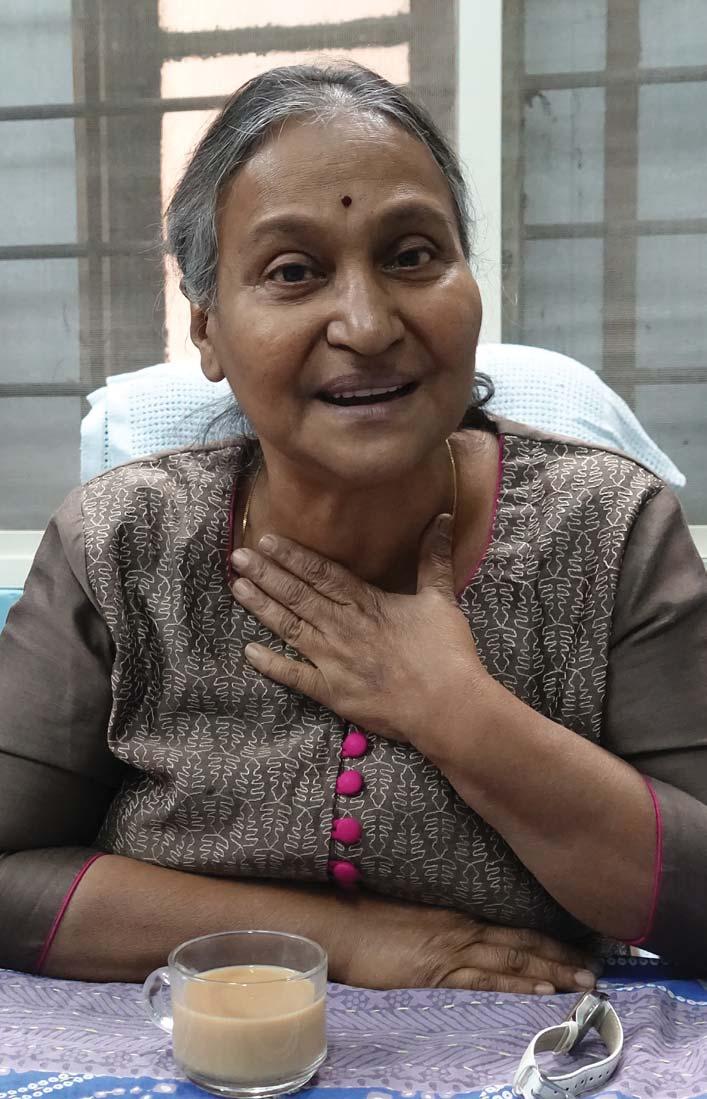
friends often give me `100 or 150 and ask me to get beer from the shop opposite our house. But they drink half and leave the rest and because it will go waste, I drink it.”
But what is even more heartbreaking is what Deepa Bhagwat, his wife, also a former president of the same club, relates. Very often, as there is no other place, children remain under the bed while their mothers are with their clients.
But the scene before me… filled with happy, chirpy kids who
are assembled in the make-shift classroom — actually a corridor which has been given a nice roof by Bhagwat, who is in the construction business… lifts the spirit. “It cost less than `1 lakh,” he smiles, adding, “We did it because the children were spending a lot of time in the open corridor, exposed to the elements, sun and rain. So we first put the roof four years ago, and yesterday renovated it again.”
His club soon got involved and next, the flooring in the kitchen was
Renu Gavaskar had an unhappy childhood as her mother suffered from Parkinson’s disease when she was only 13, and “she died when I was 25. We lived in Mumbai and those 12 years were terrible. My father was very disturbed, and four months before her death, he died of cancer. So my childhood was marked by grief and unhappiness.”
A postgraduate in Philosophy, she got a job in Saraswat Bank through direct recruitment as an officer. She was “fortunate to marry Narayan Gavaskar, a true feminist who encouraged me to go out and work for the good of society. He believed that women should have total freedom and I am indebted to him for all the good things that happened in my life. He showed me the path to every good thing I’ve done .”
He also believed that only one partner should work and encouraged her to resign, “read all the time and go out and help people”. But her married life ended in just 11 years; he died of cardiac arrest at 42, leaving the 34-yearold Renu with two young children — 7 and 9.
But he had sown in her the seed to work for society; “he’d tell me read books and work for those who don’t get love and affection.” Over 20 years ago, she decided to move from Mumbai to Pune.
Asked why, she smiles and says, “Mumbai is cosmopolitan and huge and to find a place to do such work is more difficult, as is raising funds. Pune has a heart and has given me everything. Once the people are convinced that you are sincere, they give in abundance. I never asked these Rotarians to
In Budhwar Peth I saw women who were standing and standing and waiting… just for a man, because the next meal for her and her child will come from him.
give me anything. They themselves approached me… that is the greatness of the way social and community work is done in Pune. They don’t make you beg.”
In Pune, Renu met Vijaya Lavate, an eminent social worker who has passed on. “She took me to Budhwar Peth to take care of a child with a fracture and a new world opened up to me. Of women who are standing and standing and waiting… just for a man, because the next meal for her and her child/children will come from him.”
She slowly connected with the children and their mothers in this area. “A kind builder gave me this place saying it is entangled in some legal hassles and no one is occupying it. I am sure you’ll make gold out of it, and this is our 11th year!”
changed and a platform provided. The children soon got from the Rotarians school uniforms, study material, notebooks, school bags and then desks. “They sit on the floor, and have to bend down to write. Imagine what it does to their backs. And I believe that one whose back is bent, has a bent mind too, and one with a bent mind can never stand straight, says Bhagwat, spelling out his quaint philosophy!
The children were extremely happy, because they thought “hamey
In the beginning, some of the goondas harassed her because they found their next generation slipping through their fingers, but seeing her sincere work, she has got support from some policemen and politicians too.
She would visit the area with her daughter Gowri and talk to the mothers and “they were happy to allow me to remove their children from there. I have tried to preserve the childhood of these children… they play, sing and dance, and live here.” All of them go to the Adarsh Vidyalaya, a private school and their fees are paid by the alumni. Additional teaching is done at her place and the Rotarians too help out, particularly with math and English. And Bhagwat’s sister Varsha Bhave, a renowned singer in Maharashtra, teaches them music.
bhi kuch milta hei (we also get something).” Then came the question of celebrating birthdays. They’ve found from their schools that in other homes the parents celebrate their children’s birthdays, but they had never experienced that. So now the Rotarians celebrate Renutai’s children’s birthdays by cutting a cake and presenting the child a new dress!
Dreams galore
In an interaction that is great fun, the children share their dreams, but
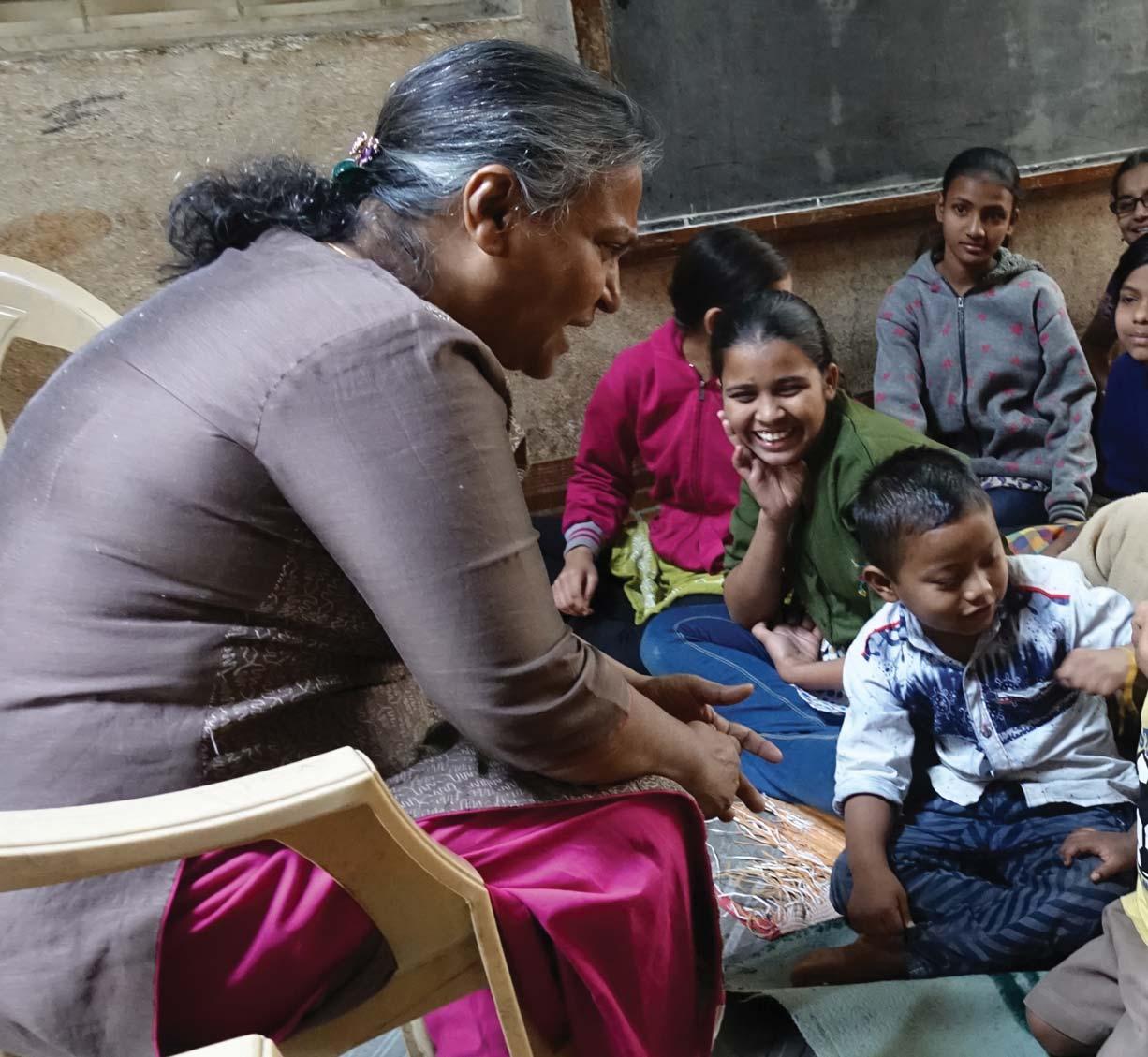
these do have boundaries. Little Tarun, a Class 4 student, articulates the most common aspiration of most of the boys, and some girls too — he wants to join the police force. So does Saloni. When asked why, she says simply, “To get justice for the people”. Elaborates Renutai, “In their worldview, the police not only beat up people but is also corrupt; they take money and round up innocent people, so she wants to help such people and get them justice.”
If she becomes a policewoman and gets a good job, will she pull her mother out of this area, I ask her gently. “I will first get a good house, and put my family together (her brothers and sisters are separated, though one sister, Manisha, is also here). My two brothers are working in a garage, but in my house all of us will be together,” she says cheerfully. Mercifully, the siblings do get together and the mothers regularly visit the children.
My husband made me give up my job to work for society. He’d tell me to read books and work for those who don’t get love and affection.

The girls, I find, are much more forthcoming in sharing their plans about the future and rescuing their mothers from their present plight. The boys want it too, but maintain a stoic exterior and don’t articulate this. Anuradha, on the other hand, doesn’t flinch when asked what she wants to do for her mother. “She is suffering and is very sad. And I won’t allow her to do whatever she is doing now because she is very unhappy. I will get her out of here
when I become a nurse and get a good job,” she says.
Quite a few want to become film heroes! “My favourite hero is Salman Khan,” Rohan smiles. Rajendra, who is a great dancer, wants to become like Salman too. Renutai is quick to add, “But the older boys here don’t like Salman because they think he has committed a crime.”
Some of the other boys want to become Superman. As the chorus of “police” continues, Renutai says,
Pune has a heart and has given me everything. Once the people are convinced that you are sincere, they give in abundance. I never asked these Rotarians to give me anything. They themselves approached me.
“There is a special dimension here; they and their mothers have been so much harassed by the police that they want to protect themselves, and the hero does the same.” Lakshmi, Anuradha’s younger sister, wants to become a soldier. “She feels that’s the only way to protect the country, the community and rescue her mother. You can see the repercussions of these children being without somebody to protect them and provide for them. The dreams are different; while other children want to be successful and happy, these children want to overcome their suffering,” she sighs.
The primary motive behind Renutai’s passion and devotion towards these children, and her determination to return their childhood to them, is to prevent child trafficking to the extent she can. She has no doubt that if left there, almost all the girls will end up being trafficked. “and don’t think the boys are safe. Look at Rohan, he is so handsome, and he knows that too! But he is at great danger too.”
From paedophiles, I ask, my heart sinking. “Not so much that, as being groomed to trap women into love marriages and lure them to the red light area from where escape is impossible,” says Renutai. She then

Deepa and Sadanand Bhagwat with the children.
Theresidential home where 50-odd children get additional schooling, run by the Ekalavya Trust in Pune, now operates out of a Pune Municipal Corporation building that is caught up in some legal dispute as the contractor delayed construction. The case is pending for 20-odd years. After Renutai started her venture to prevent child trafficking, 11 years
ago, the builder told her, “Anyway this building is lying unutilised, so why don’t you use it till the court decision comes.”
Now the dates for the case have been given and a judgement is expected. “We thought if this building goes back to the Corporation, these children will return to the same hell. So we are trying to give them a
permanent place and have the commitment from NRI donors — Sudha Mahurkar and her 3 daughters — in the US, who are my clients, for ` 4 crore. The funds are ready to construct a good 7,000 sq ft facility for these children within a year,” says Sadanand Bhagwat, former president of RC Pune Laxmi Road.
But the donors’ requirement, to save on tax, is to donate this amount from their Trust in the US through a voluntary organisation based there. This can be done if a US Rotary club agrees to accept this money and then do a sort of joint project with the Rotarians in Pune, to ensure these rescued children get proper education and a decent livelihood.
Bhagwat says he has identified a 15,000 sq ft plot near SUS, on the outskirts of Pune city, and here a hostel for the older girls can be built. But the Rotarians are also committed to taking care of the 60-odd street children who now reside in Pune behind KEM Hospital, also run by Renutai.
He has also identified a plot of about 6,000 sq ft to put up a building for these children in Ambagaon, on the outskirts of Pune. “So these, and even other possibilities are there, but we have not yet managed to identify a partner club in the US, as the amount involved is rather big — around $600,000. The moment we find a partner club in the US, these children can be saved from an uncertain future,” adds Bhagwat.
relates the heartbreaking story of a nine-year-old girl she had rescued, but who was sold by her mother, “who was in debt, without our knowledge. She was a beautiful girl, we tried so hard but she just disappeared. When we approached the middleman trying to get her back, one of them said: ‘Aap itna dukh kyo karti ho, woh ab Bangalore ki khidki mei hei, yaha nahi (Why are you so sad; she
is now in the Bangalore trade).’ That was some 15 years ago during the beginning of my work. And then I understood that every girl has to be protected. As boys too; to be fair and beautiful/handsome is a curse in this place.”
Boys, she adds, apart from being used to trap girls into marriage and bring them into the flesh trade, are also used for child labour, fetching
food, daru and other work. “The child is happy because food is his necessity, education is not, and child labour is so much cheaper.”
In her other facility, she has rescued 62 street children and put them in schools. “But I know there are another 62,000 boys who’ve come from villages and are staying on the

pavements. I’ve told myself thus far and no more… jitna ho sakey utna karo (do what you can.) My daughter Gowri,who is with me, will carry on my work, I know.”
So what happens to the remaining street children?
“They go into crime… those living on the streets can commit robbery, murder or get into the prostitution racket. They go into crime because there is no alternative; they take drugs… so who will give them jobs? On the Pune railway station, you’ll see so many children roaming around. They know us by face, and run away when they see us because they don’t want to come here. They feel imprisoned, and who will give them drugs? They are happy with the vada pao they get by begging.”
She feels unless there is a herculean effort from the government,
Every girl has to be protected, and boys too; to be fair and beautiful or handsome is a curse in this place.
“these children cannot be rescued, and will continue to be trafficked or end up in criminal activities.”
So what percentage of girls does she estimate ending up doing their mother’s job?
Directly, a very small one, she says, “because the mothers don’t want their daughter to enter this hell.” But the girls get married… it’s a love marriage mostly, but “what happens to them we don’t know. Because some of the men they marry… mahol
toh wahi hei na… are already married, and ultimately abandon them. They often return with a child.”
Asked if the children’s fathers visit them, Renutai says some do, “but often it’s a false identity. The children accept somebody the mother brings; he leaves and some other man comes but they will accept him too because there is so much violence in their lives that they need a male member to protect them… they witness this violence daily, sometimes, tragically, from under the mother’s bed.”
Small wonder then, that having seen their mothers being subjected to cruelty so often, these children regard women as the weaker sex.
Pictures by Rasheeda Bhagat
Designed by Krishnapratheesh S
President-elect Barry Rassin on where Rotary has been, where he hopes to lead it — and how the organisation profoundly changed his life

RI President Elect Barry Rassin
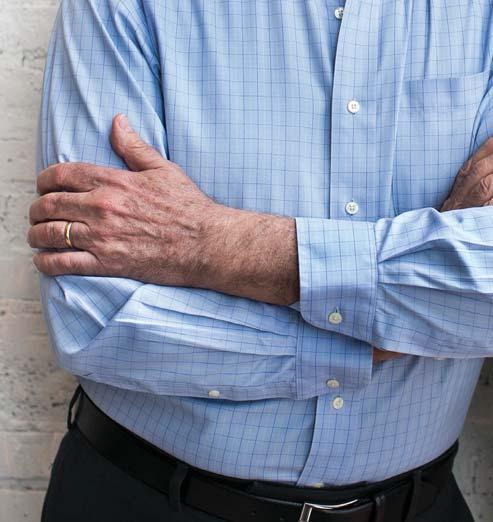


WhenBarry Rassin arrived at the Rotary headquarters in Evanston at 4 am for his first full day as presidentelect, his security card wouldn’t work in the elevator. Just the day before, in a whirlwind process, he’d been nominated to fill the vacancy of Sam F Owori, who had died unexpectedly in July. Now Rassin, a member of the Rotary Club of East Nassau, Bahamas, didn’t have the right credentials for all-hours access to the building. “I had to explain the situation to the security guard, who of course didn’t have a clue who I was,” he says.
Not much can stop Rassin when he wants to get something done. After making it up to the 18th floor of One Rotary Center, he set about compressing five days of orientation into a day and a half, planning the International Assembly, and coming up with his presidential theme: Be the Inspiration. “My personality is such that I want to hear all the options, make a decision, and go on to the next thing,” he says. “So we moved through the process fairly rapidly.”
Before becoming president-elect, Rassin was best known for leading Rotary’s relief and recovery efforts after the 2010 earthquake in Haiti, which included 105 separate projects funded by Rotarians. “I had a spreadsheet with 132 pages and every detail of every project,” he says. “People look at it and say, ‘How do you do this?’ But I enjoyed that.”
Rassin’s leadership abilities served him well in his professional life as a hospital administrator. The first fellow of the American College of Healthcare Executives in the Bahamas, he recently retired after 37 years as president of Doctors Hospital Health System, where he still serves as an adviser.
Rassin has been a Rotarian since 1980 and received Rotary’s highest honour, the Service Above Self Award, for his work. He and his wife, Esther, are Major Donors and Benefactors of The Rotary Foundation.

Editor-in-chief John Rezek and senior staff writer Diana Schoberg from The Rotarian spoke with Rassin at his office in Evanston in October, shortly after a photo shoot in a local coffee shop. A birthday party had been booked in the shop at the same time, but the partygoers didn’t seem to mind. (“He’s movie star material,” one of them whispered.) Afterward, Rassin joked about the photo shoot: “It was like going to the dentist.”

THE ROTARIAN: Rotary is not a disaster relief organisation. As someone who has had a front seat to some of the worst disasters of recent times, do you think we should make any shifts?
Rassin: Yes, Rotary International is not a relief organisation, but I would like it to be a much better communicator and catalyst between disaster areas and potential donors. Rotarians around the world hear of a disaster and they want to help. We need a better way to communicate to them how to help appropriately. It’s not appropriate to go in your closet and send whatever clothes you have, because that’s not necessarily what’s needed. First we have to hear from people in the disaster area. Their needs can change on a daily basis, so that communication is really important. I hope we will have more up-to-date information on our website about every disaster as it occurs.
We have a Rotarian Action Group focused on disaster assistance. That group has a great opportunity working with the staff at Rotary International. We can respond more quickly than we
do today. The first thing we have to do in a disaster is reach out and say, “Are you OK? We’re here, we care, what can we do to help you? ” Just those words make people in that area feel less alone. Then we can advise them about how to get the immediate relief we can’t provide, through those agencies that we already work with.
TR: Is Rotary dependent on clubs for this information?
Rassin: The clubs and districts are on the ground. They know what’s going on. They’ve got to know who and how and when to contact somebody at Rotary International for assistance. We have to provide that link. That’s Rotary International’s job.
If you live in that disaster area, you’re going to give immediate relief because your friends are hurting. That’s natural. Rotary’s bigger role is the next step, the long-term recovery efforts.
It’s been eight years since the earthquake in Haiti, and Rotary International is still there. A lot of other
agencies provide immediate relief, and then they’re gone. We’re there for the long term. The Rotarians live there; they’re going to want to get their community back to where it was. Our role is to help them do that. Not necessarily with funds, but with advice, with guidance, and with empathy.
TR: You want Rotary to have a transformational impact. How should we allocate our resources to do that?
Rassin: It’s OK to do small projects — don’t get me wrong. We’re always going to be doing them. But I’d like every club to think of at least one high-impact service project they can do to change people’s lives. They don’t have to cost a lot of money. I always use the jeep we provided in Haiti as an example. For $60,000 or $70,000, we provided a pink jeep to a group of midwives who go out into the community and give prenatal care to mothers who wouldn’t get it any other way. The mortality rate has gone down dramatically. That’s transformational.
The Rotary Foundation has talked about sustainability for a long time. To be sustainable — to make the good we do last — you should be transformational, so that fits well into what the Foundation Trustees and global grants are doing. The districts could look at district grants and do the same kind of thing. We have the resources. We just have to think a little differently.
TR: Did the act of rebuilding in Haiti have a positive effect on Rotary?
Rassin: If you go into certain parts of Haiti with the Rotary wheel, they’re going to say thank you, because they know what Rotarians have done. Rotary has provided them with food, with water, with a school for their children. When we talk transformational, one project we’ve been working on is to bring potable water to the entire country of Haiti. The prime minister is a Rotarian and past president of his club. He is working with us, and he’s got a government agency that’s going to work directly with us. That’s way above any global grant, but we can plan for that and figure out how to do it in chunks. I’m sure districts and clubs around the world would love to be a part of it. That’s transformational. That’s the kind of thing that could change a region for the better, forever.
TR: What other goals do you wish to accomplish during your year?
Rassin: There’s a disconnect between what we do at Rotary International — and do really well — and what Rotary clubs are doing. I’d like to bridge that gap. One of our strategic priorities is strengthening clubs, which involves things like membership and Foundation giving. We’re not reaching the clubs to get them to understand why we need to do some of these things, and therefore some don’t do them.
I want to explore ways of starting new Rotary clubs. There are a lot of clubs out there. We keep telling them, “You’ve got to get new members.” But their club culture may not be attractive to other people. Fine — they should enjoy their club, and then start another club next door. We’re
working on making sure everybody knows that Rotaract clubs can start Rotary clubs. We need to tell Rotaractors they can start a Rotary club they’re comfortable with when they move on after 30. Rotaract is our secret weapon, and we need to spend time developing the transition from Rotaract to Rotary in a different way.
We’ve got to get better at social media. When you look at our numbers versus a celebrity’s, we’re nothing. We need Rotarians and Rotaractors to access social media and use it to improve our public image. And that’s the other part of it: I don’t believe our communities understand what Rotary is. I want to hold Rotary Days so clubs and districts can get into their communities and talk about Rotary — what do we do and why do we do it.
I want clubs to have leadership development programmes for their members. Rotary’s new vision statement says: “Together, we see a world where people unite and take action to create lasting change — across the globe, in our communities, and in ourselves.” It is a great opportunity to remind everybody that as members of Rotary clubs, we’re also there for personal development. Young people are looking for ways to grow and develop, and that gives them another reason to join Rotary. Those are the key things I want to go with.
TR: You mentioned Rotary’s new vision statement. We already have a motto, Service Above Self. We have presidential themes every year. Why do we need a vision statement too?
Rassin: A vision statement allows us to tell the world what our ultimate value is for the long term. It helps Rotarians and non-Rotarians understand what our goal is when it comes to changing our world. This vision statement came from Rotarians, who recommended each phrase. The end result shows our vision for the future and the path to get there.
TR: Rotaract and Rotary clubs in the Caribbean have a good relationship. What’s the key?


Rassin: My club is an example. When Rotaractors come to our club, they’re not our guests for the day. They sign in as members. So right away they’ll feel like they’re a part of us. That’s important. We also make sure that a Rotarian from our club always goes to Rotaract meetings so there’s always a connection. In the last two years, I believe we’ve got 100 per cent transition from Rotaract to Rotary. They come and join our club because they know us. We’ve got to keep that connection going.
TR: What have you learned from Rotaractors?
Rassin: Rotaractors are energetic. They’re passionate. They want to do good, and they really like working with each other. The frustration is that they then find it difficult to transition to a different club that has a totally different culture, doesn’t have the energy, doesn’t even know how to use social media. Rotaractors are the Rotary of the future, and we need to help them get there. What are they going to want in a club when they’re 40? We have to come up with that answer and then create Rotary clubs, or help them create Rotary clubs, that can get them there.
TR: Imagine your life without Rotary.
Rassin: Wow! That’s hard to do, to be quite honest. I have put my heart and soul into Rotary for 37 years, and without it I wouldn’t have the friends I have or the ability to do some of the things I can do. I always give the example of my first speech. I was holding on to the lectern reading the speech I wrote, and when I got to the bottom of the first page, I was so nervous that I couldn’t turn the page. But my club kept asking me to speak, so I kept doing it, and now I speak publicly with confidence. I couldn’t do that without Rotary.
TR: How do you begin a speech?
Rassin: It’s important to recognise and acknowledge who’s in your audience. You want to connect with them in one fashion or another, either by saying thank you or it’s nice to be here, or by recognising a particular individual. Whenever I make a speech, I want to make it as personal as I can.
TR: If there’s one thing you could change about Rotary, what would that be?
Rassin: One of our challenges in Rotary is our Council on Legislation. We meet every three years to consider changing Rotary’s governing policies, but it takes more like four and a half or five years to accomplish this because of the deadlines to propose legislation. The world is changing far too fast for that. We need a way to make major decisions that affect the organisation on a quicker basis. Our Council on Legislation needs to understand that maybe it’s time to make that change. I’d love to see our Council restructured. One way would be to conduct those meetings electronically every year. It would be a challenge because it’s hard to have a dynamic debate online, but I think Rotary is smart enough to figure out how to do that.
TR: Is there a Rotary tradition you would never get rid of?
Rassin: I would never get rid of our Four-Way Test. I would never get rid of vocational service. Some of the traditions from weekly club meetings could go. I don’t think there’s a need to be that formal in a club meeting anymore. But when you look at core values or ethics or classifications, those are things that have to stay with us. That’s who we are and what makes us different, and we need to appreciate that and keep developing those principles.
© The Rotarian
people people of

Rasheeda Bhagat
In this issue, we bring to you a story of how a Rotarian who is passionate about serving the community she lives in, can use her own business or profession to make a difference in people’s lives, and this not through one, but two projects. Pratiksha Mayee, a member of RC Nagpur Downtown, D 3030, is a deputy GM of Ankur Seeds, and was disturbed to see the state of farmers in the Vidarbha region of Maharashtra, where her club is located and which is severely affected by drought. Vidarbha has often been hitting the headlines for all the wrong reasons — mainly farmer suicides.
“Making matters worse, this year the region has been widely affected by the pink bollworm that has devastated the cotton crop, the main crop of this area,” says Pratiksha. To stop the havoc caused by this pest, many Vidarbha farmers resorted to the indiscriminate use of numerous pesticide sprays. The excessive use of chemical pesticides and lack of precautions while spraying the cotton plants “were some of the reasons for the death of farmers and this has become a politically sensitive issue,” she says.
Since she deals with an agricultural product, she thought of doing
a service project concerning farmers and first of all got consent from her company to support the project that aimed to educate farmers on the safety measures and precautions to be taken while spraying chemical pesticides on their plants. “Our President Vijay Thakare and Secretary Dr Rishikesh Mayee agreed and together we planned the project” to spread awareness on the dangers of chemical pesticides among the farmers of the club’s adopted village Gumthala, which is about 35 km from Nagpur.
Invitation letters were sent out to the farmers in this village, requesting them to attend the awareness

Many club members had consulted me on trying new ways to grow their own food, and thus the project ‘From Pot to Plate’ came about.
Pratiksha Mayee

The Pot to Plate project.
programme planned by the club. “Over 90 per cent of the farmers in this village grow cotton, the other crop being chilli. We took extra care to involve the women from the farming families, as they work along with the men on the fields, some of them as contract labour, and hence were the ones who had carried out the pesticide spraying,” says Pratiksha.
The village sarpanch and his members were also invited as guests for the programme so that awareness was spread amongst the village heads to enable them to do a follow up in the village during the cropping season. More than 100 farmers from Gumthala and nearby villages attended the programme, which was sponsored by the Indian Society for Cotton Improvement, Mumbai and Ankur Seeds. Scientists Dr H L Sawal and Dr Subhash Potdukhe from the Agriculture College, Nagpur, were invited to talk about the judicial use of chemical pesticides and the importance and much larger ecological benefits of using bio-fertilisers.
A team of experts from Ankur Seeds demonstrated what safety measures should be taken while using chemical pesticides. Safety kits containing hand gloves, a cap, protective
eyewear and a mask were distributed to some of the famers.
The Sarpanch Sushilatai Jamgade was grateful to the club for carrying out this programme and said the crucial information given to the farmers at that meet would go a long way in saving farmers’ lives.
Another innovative project, also done by the club thanks to the initiative taken by Pratiksha, who is a member of the board in her club as well as Editor of its monthly magazine Downtown Buzz, has been named ‘Pot to Plate’. This is a simple project aimed at educating Rotarians about the importance of consuming organic produce free from pesticides and injecting enthusiasm in them on growing their own vegetables and herbs.
“The background is that many of our club members had consulted me on trying out new ways of growing their own food. So the idea of taking up this project shaped in my mind,” she says. Rotarians were guided on how to take up vegetable farming in pots on their terrace or garden.
“This spread a message not only about eating healthy and fresh food but also about the need to make our
environment green,” says Pratiksha. She attached a small packet of seeds of vegetables such as tomato, chilli, brinjal, beans and cowpea, sponsored by her company, to the June issue of the club’s magazine Downtown Buzz, and sent them not only to the 100 members of her club but also the district officers, “so that members could learn through the article written by Rtn Saish Kashikar how to sow the seeds and grow their own vegetables. Members were advised that green leafy vegetables like spinach, fenugreek and coriander would not only give a great green look to their terrace or garden, but also provide a never ending supply of nutritious vegetables for their daily meal requirements,” she adds.
Expectedly, the Rotary Anns and their children showed a lot of interest and enthusiasm and planted the seeds, and took care of their baby plants and reaped a rich dividend.
Soon Pot to Plate became a big hit and photos were shared among Rotarians and feedback shared on how they felt at the first sight of the first chilli or tomato. “This project was appreciated by our DG K Sunder Rajan and Rotarians from other clubs in our district during the recently held district conference,” she adds.










If the pilot programme being carried out in some countries of the Rotary world is a success, Rotary International may soon open its doors to corporate membership, RI Director C Basker revealed at the Disha training event held for the incoming District Governors at Hyderabad in February.
“The RI board is studying the global membership model, and if all goes well, our membership might be opened for corporates from July 1,” he said.
The impeccably conducted event chaired by PDG Sam Patibandla was
From L: DGEs Praveen Goyal (3080), Nikhilesh M Trivedi (3261), Shashi Sharma (3141), Priyesh Bhandari (3053), C R Chandra Bob (3231), Vishwa Bandhu Dixit (3090), R V N Kannan (3000), Dushan Soza (3220), Neeraj Soghani (3054), DG Maullin Patel (3054), DGEs Ashes Ganguly (3142) and Ramesh Vangala (3150) at the Disha Meet.









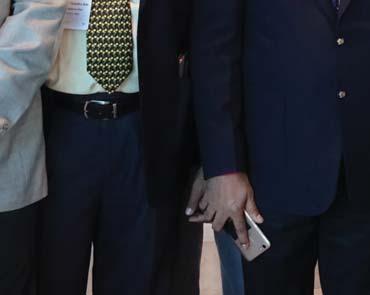



attended by nearly 180 delegates. There were some lighter moments but mainly tough talk on maintaining standards in membership and the district leadership helping the clubs become stronger and more vibrant. Apart from the DGEs, Rotary Coordinators, Regional Rotary Foundation Chairs, Rotary Public Image Coordinators and Endowment Major Gift Advisor, as well as the District chairs of all these verticals from all the 39 districts, including Nepal and Sri Lanka, participated. While RISAO Head Rajeev Ranjan, Sanjay Parmar and Jatinder Singh, represented the RI South Asia
office, Nayish Shah was there from Evanston to explain details of the Rotary Global Rewards.
Addressing the meet, Director Basker said, “Rotary in India has grown considerably and we have stunned the world with the growth we have shown in the last 10 years. The entire Rotary world looks at us with respect now because we have become No 2 in TRF giving and also because we do wonderful projects across our zones.” And yet, whatever was done was not sufficient as our country had so many challenges and problems and there was so much more work to be done. “So there are

RI Director C Basker



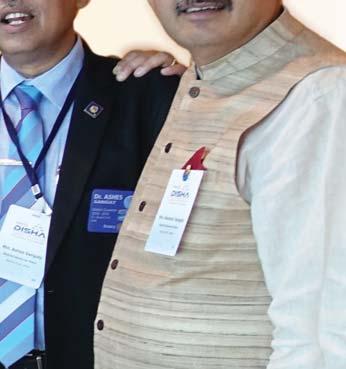
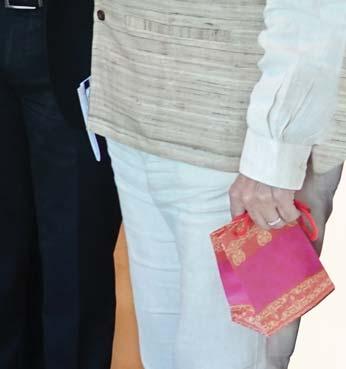

huge expectations from this batch. We need to set new trends, but I urge you that while setting goals, either on membership or Foundation giving, do set realistic goals which can be achieved.”
He said that in the earlier years “we have been saying big things and based on all those promises I had assured the RI Board we will achieve such and such goals but then barely 60 per cent was achieved. So be cautious and without lagging behind, set realistic goals.”
In what was a highly interactive training event with many breakaway group discussions, Basker said the DGEs should always bear in mind that the district “exists solely to help clubs; the entire activities of the district should focus on how to support and strengthen clubs. Remember that the district is not an independent entity. But unfortunately, the opposite is now happening in our zones as the governors and districts organise parallel or competitive programmes with the clubs rather than support them in their activities.”
The DG has to form a team to help the clubs to get members, funds for TRF, etc, but “touch your hearts and tell me if this is really happening,” he asked.
Basker admitted that he was not really aware of the extent of We have grown considerably in India in the last 10 years and stunned the world with our growth. The Rotary world looks at us with respect now because we do wonderful projects and are now No 2 in TRF giving.

this malaise last year, but “I started realising this only a few months ago. We learn all the time; so I want the DGEs to understand that your job is to train your presidents and secretariats at your district assemblies and other training events.” He urged the DGEs to ensure that the district training events were restricted to the club officers and not all and sundry.
Why do we allow a minuscule number of Rotarians to bring us disrepute. You are tomorrow’s leadership and you must show zero tolerance for corrupt practices.
Trustee-elect Gulam Vahanvaty
Clubs are independent
The Director said all DGEs have to understand the basic credo that each Rotary club is an independent entity, and if certain Rotarians are not up to the mark or indulging in dubious activities, only the club president, and not the DG, has the power to remove those Rotarians from the clubs. “This is because every club is autonomous and is supposed to have its own constitution and bylaws. As incoming DGs you have to create this awareness at your PETs and SETS, and tell them how they can amend their bylaws.”
On the size of clubs, he said that the district membership chairs would have to ensure that clubs have a minimum of 20 members, and sought an assurance from them that by Jan 1, 2019 there weren’t any clubs in our zones with less than 20 members. Those with less than 20 members could be merged.
When he got a loud assurance from the assembled Rotary leaders,
Basker said: “I am a very effective fellow, I don’t forget things that easily, and I follow up! If you don’t succeed, for every member less than 20 in a club, I have assured Trustee Elect Gulam (Vahanvaty) that the DMC will have to pay $100 to TRF! Gulam had originally said $1,000

From L: RID C Basker, Disha Chair Sam Patibandla and RPIC Raja Michael.

but I made it
100! I am not the only Hitler here!”
He asked the DGEs to delegate responsibility to their district leadership teams and said a five-year analysis had been done on why people leave Rotary which will be
shared with them and which should be followed up by the district membership chairs.
Participating in My Rotary was a must; he was sorry to say that only 30 per cent of clubs had put down their goals in Rotary Club Central. “Ensure every single club registers there before July 2018.”
Also, he added, the purpose of Rotary was to serve the needy, “so please do projects that are needed by the community. TRF has $52 million available in DDFs which will be carried over, so use it effectively through your DRFC.”
Basker added that many clubs were not giving anything to TRF and this was unacceptable; “ask each member in your district to give at least $100 and they might end up giving $26.5, which should be the bare minimum.”
Addressing the conference, Trustee Elect Vahanvaty urged the DGEs to keep

At the Disha training event for DGEs and district leaders, RI Director C Basker read out the riot rule on the conduct of district training events and laid down some strict guidelines. He said that PETS and SETS were the most important training programmes for the DGEs “because unless the clubs perform, you can’t reach the targets you have set. So please take these training events seriously and don’t allow anything to dilute them. Some of you were planning to take these out of the country, which I stopped. And next year if you want to take your training programme outside the district, you will need permission.”
This was because many complaints had gone to RI from India that training programmes are becoming very expensive. While he understood their desire for foreign travel and the charm it held, the training programmes were sacrosanct and all the district chairs should be invited to them.
Also, he urged the DGEs to print the club president’s manual in regional languages and distribute them so that club meetings were conducted properly. “Last year I did it from my own pocket as it was an introductory offer, but this year I am broke, so you will have to do it!” Soft copies of the handbooks in various regional languages would be shared, and printing copies cost barely Rs 30-40 a copy.
Also, the Director added, the DGEs should avoid too many events as nowhere in the world as many Rotary events are held as in India. This puts pressure on both the members’ time and finances. Also club meetings should be confined to 45 minutes, and started and closed on time. “Also, please start your DG visits as early as possible as only then can you know about the clubs’ problems and give them solutions. Finish your visits within nine months, and do all your communication via email. If the office-bearers don’t have email IDs, don’t keep them as your office-bearers,” he added.
their focus on getting the world rid of polio and inculcate the habit of giving among the Rotarians however small the sum. “Last year was an absolutely record breaking year for TRF both internationally and in South Asia/India, and it was a matter of great pride for us in India as the man at the helm of affairs was PRIP Kalyan Banerjeee as the Trustee Chair.”
Your challenge is to pass on the knowledge and energy to your district teams all the way down to the clubs. Disha is conceived with that major goal in mind.
DISHA Chair
PDG Sam Patibandla
Based on last year’s performance Trustee Chair Elect Ron Burton has set an ambitious goal of $380 million for the coming year.
Vahanvaty said that apart from ending polio “in accordance with the commitment we’ve made to the children of the world”, increase in membership is RI’s highest internal priority. The other one is “to increase the scalability of our service projects in all our focus areas and ensure their sustainability. The third priority is what Director Basker has already touched upon; using the DDF that is available to us. Please encourage your district to use every bit of the DDF available to us to do good in the world.”
He said that while in some districts the amount was very large, in other districts in our zones which can’t raise too much money, funds were needed to do projects. “So those districts blessed with large DDFs please take care of districts in need. Remember that Rotarians
have given funds to TRF so that you use it and not to make it into a savings account.” The fourth priority is to build the permanent fund and encourage endowments. “The permanent fund is Rotary’s fund for the future. Our goal is that by 2025 we will build this fund to $2 billion and 25 million. Just imagine what can we can do with over $2 billion in our kitty generating interest every year.”
Vahanvaty said the other need was to “keep in touch with our alumni and at the right time invite them to join Rotary. Just like me. I was a GSE team member in 1978 and I was invited to join Rotary in 1979. And one who has been on a journey from a GSE team member to a Rotary member to RRFC and now a TRF Trustee Elect, let me tell you that each of us is given an extraordinary opportunity to serve our community.”
The other pressing need was to expand the donor base and make Rotary a charity of choice, as it had

been given a four-star rating on the two parameters, financial health and transparency, by Charity Navigator which rates over 9,000 charities in the US. “In 2017, for the 10th year in a row, TRF received a 4-star rating, the highest rating they give, and was on top of the chart with two other NGOs.”
Jatinder Singh made a comprehensive presentation on using online tools and explained the process through which club invoices were generated and how if the presidents did not act in time in deleting names, the invoice generated including the dues for members who had left, could not be altered.
Rotary leaders such as RCs Ashok Gupta and Rajendra Rai; RRFCs Vijay Jalan and Avinash Potdar; RPICs Ashish Desai and Raja Michael and EMGA Ashok Panjwani briefed the DGs on the current state of affairs in each of these verticals and interacted with them in goal setting.
Welcoming the delegates to Hyderabad, the “city of pearls, biryani and love, and known for its hospitality right from the time of the Nizam, Disha Chair Sam Patibandla said the idea of this event was to bring together the incoming governors and their core team to discuss and exchange ideas, learn from and motivate each other and interact with the

Atthe Disha conference, Trustee Elect Gulam Vahanvaty expressed grave concern over a mere handful of Rotarians sullying the image of Rotary in India by indulging in corrupt practices. He said Trustee Chair Elect Ron Burton had set an ambitious goal of $380 million for TRF next year. And in this goal, a lot was expected from India. “TRF has always counted on us and we have responded willingly; last year we were No 2 in giving. With so much to hold our heads high, why should we allow just a handful of Rotarians to give us a bad name?”
He said that on the last day of the International Assembly held in San Diego, when the DGEs were addressed by senior leaders such as PRIP and TRF Trustee K R Ravindran, Director
RI Director, Trustee Elect, the RCs, RRFCs, RPICs and EMGA and seniors from the RISAO.
“Now the challenge is to pass on this knowledge and energy to your district teams all the way down to the clubs. Disha is
Basker, Trustee Sushil Gupta and himself, “what was shared was disturbing and I was extremely upset and I know many of you are also upset because you later spoke to me. I asked myself how many Rotarians are there who do such things that causes disrepute to us… 20, 30, 40? Even if it is 40, when you take it against a conservative figure of 1.4 lakh Rotarians in India, the percentage is a mere 0.003 per cent! And we allow this minuscule number to bring us into disrepute. You are tomorrow’s leadership; let us buckle up and not allow anyone to sully the name of Indians in TRF.”
He added: “We must have zero tolerance not because the Trustees demand this of us, but because all of us will not tolerate questionable practices. We owe it to ourselves and our donors.”
conceived with that major goal in mind: to facilitate, discuss and interact and come out with an effective and practical way to conduct your district events such as PETS, and the district assembly,” said Patibandla.
Host DG J Abraham welcomed the delegates and Disha Secretary TVR Murti took care of all the logistics.
Pictures by Rasheeda Bhagat Designed by Krishnapratheesh

Rotary Club of Delhi Ashoka, D 3012, with support from RC Box Hill Central, D 9810, Australia, renovated existing toilets, built new ones and provided handwash facilities in a school at Gejha near Noida. The project, costing $30,000, has
been implemented with TRF’s global grant and is one of the 11 government schools the club aims to modernise, in partnership with an Australian partner. World Vision India is supporting the project for capacity building. The infrastructure addition was inaugurated by Union Minister of State for Culture and
Environment Mahesh Sharma, in the presence of Unicef India WASH Specialist Pratibha Singh, TRF Trustee and WinS Target Challenge Committee Chair Sushil Gupta, Committee Member Ramesh Aggarwal and Mark Balla of RC Box Hill Central. PDG Sharat Jain, DGE Subhash Jain, DGN Deepak Gupta and
The Rotary Foundation, in consultation with RI Director C Basker and WinS Chair Sushil Gupta, has formed a new committee — the Rotary India National WinS Recognition Committee — replacing the district recognition committees formed earlier in every district. This new structure is designed to streamline communications and provide better support to Rotary clubs interested in the Target Challenge and will be operational till 2020. The team comprises 12 Rotarians — PDGs Raman Aneja, Sarbjeet Singh, R Reghunath, Ganesh G Bhat, Arjit K Endow, Bindu Singh, Ramesh Aggarwal and past presidents Hemant Jagtap and Balasubramaniam, with PDGs Sambasiva Rao Patibandla (D 3150) as Chair, A B Mohapatra (D 3262) the Vice Chair and Ramesh Agrawal (D 3054) the Secretary.
Thirteen of 46 applications from the five Target Challenge countries were shortlisted for Phase I of the WinS Competitive Grants which involves $10,000 for assessing community needs. The WASH in Schools steering committee has recently shortlisted six districts, of which two — D 3131 and 3211 — are from India, for the second phase funding of $150,000 – 500,000.

DGND Alok Gupta also participated.
The Rotarians equipped the toilets with ramps for easy accessibility of differently-abled children, beautified the school with better flooring, a fresh coat of paint and rebuilt the compound wall. A Bal Sansad was formed where children spread the message of health and hygiene and ensured its practice among their classmates. Children, as agents of change, took the message home to inspire their parents and neighbours on hygienic practices and persuade them to build toilets and
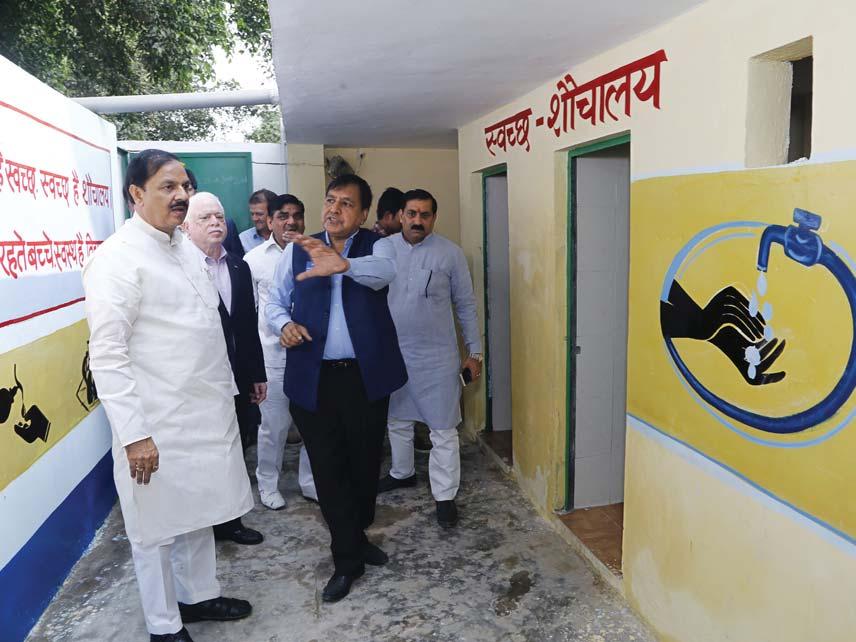

Above: WinS Target Challenge Committee Chair Sushil Gupta and Member Ramesh Aggarwal with Union Minister of State Mukesh Sharma during the inauguration of toilet blocks in the school at Gejha.
Left: Students demonstrate group handwashing for the guests.
stop open defecation.
“I was surprised to note the upsurge in attendance and we are also getting several enquiries for new admissions for the next academic year, thanks to the Rotarians,” said School Principal Hariyali Srivastav. Teachers were also trained to supervise and educate the children.
Complimenting the clubs’ initiative, Trustee Gupta reiterated his concerns for ushering in behavioural change in the
society as a whole for a sustained accomplishment. Union Minister Sharma pointed out that the ‘group hand washing’ practice is a path breaking concept which will ensure children learn and promptly follow the handwashing exercise at appropriate times. The club’s initiative should inspire other local schools to seek Rotary’s help for similar interventions, he said.
Designed by L Gunasekaran
people people of

Rasheeda Bhagat
Once while traveling from New Delhi airport Anup Karwa, President of RC Jalna Midtown, was struck by a simulation kiosk that the Indian Air Force had set up there to provide an opportunity to young travellers to explore how an aeroplane operates. A small two-computer desk could provide simulated learning on aerodynamics “and this was so inspiring that it made me think about so many things that affect our education system,” he recalls.
He realised that while private schools can make available the resources necessary to satisfy the
RC Jalna Midtown
President Anup Karwa presents a demo of the virtual science lab to PRIP Kalyan Banerjee.
DG Vyankatesh Channa (right) is also present.
young students’ curiosity on so many things, particularly science, government schools were struggling to provide even decent basic education. “My mind started exploring new thoughts on how to empower at least some Government schools with such tools by expanding the scope for learning in physics, chemistry and biology. Inspired by two legends, former President of India Dr APJ Kalam for his devotion to science, and Past RI President Kalyan Banerjee for his exemplary guidance to the Rotary India Literacy Mission, RC Jalna Midtown thought of a project to empower the next generation of Indian students

with science-savvy tools to kindle an interest in them to pursue a career in science,” says Karwa.
The result was the creation of a lab project named after Dr Kalam, “which is a disruptive virtual simulation lab project that can be accessed digitally from any computer or tablet; it just requires a standard PC with an internet connection.” Named Kalam Kids, this virtual lab has been developed by a Danish partner and can enrol a high number of students at an affordable annual subscription. “This tool has bagged many innovation awards including the disruptive technology featured in TED talk,” he adds.

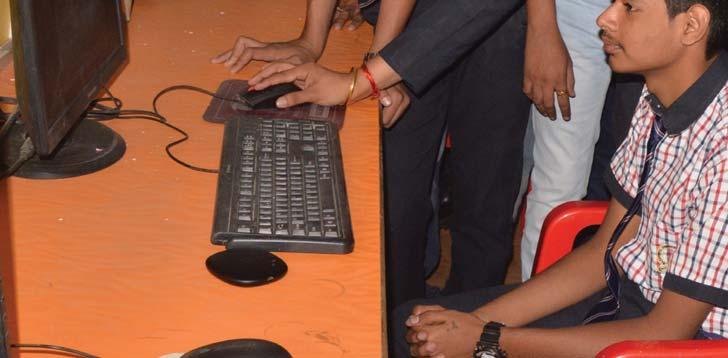


Inaugurating the first lab at the RHV English School in Jalna, PRIP Banerjee said he was amazed by the computer savviness of the young generation, including the kids at the seven schools who had come for the event.
“It has revealed to me how closely connected our younger generation is to everything that has to do with computers. Most of the students we have here are interested, committed, and are obviously enjoying their engagement with computers.”
If I need some information or try to understand something, I ask my 11-year-old grandson and he does it in a few seconds. That amazes me, and I am really proud of you youngsters’ intelligence and IT awareness.
Kalyan Banerjee Past RI President



But most of the people who are “two generations older, like I am, are not only at sea but also a little scared of IT and try to stay away. If I need some information or try to understand something, I ask my 11-year-old grandson and he does it in a few seconds. That amazes me, and I am really proud of you youngsters’ intelligence and IT awareness.”
He had been asked to speak on how to build young leaders. “My own experience is that it doesn’t matter if you are not rich. I know young billionaires of today who are hardly 22; they wear jeans and tee shirts, but have 10 times more money than I could ever make! So intelligence gets you there, but along with hard work, honestly and sincerity.”
Laying stress on integrity and honesty, Banerjee related one of the less known stories from Gandhiji’s life. When he was in the Nagpur jail, Kasturba visited him every day. Once, during such a visit, the jail representative went out and returned after 20 minutes, and found the two holding hands but not talking. When he expressed surprise, Gandhiji told him that according to the prison rules, they could talk only in front of a prison
representative. “Since you went out for a while, we stopped talking”, he said.
“Now this is real honesty; it comes from inside,” Banerjee added.
Project Chair Rtn Anuj Bansal said that thanks to the low cost of internet connectivity, it is now possible for a larger population to “adopt such cutting edge tools to generate more scientists for tomorrow.”
He added that their club wants to empower government schools of Jalna region by providing them with a PC with secure internet connection and such a virtual lab with a licensed subscription that can provide access to over 31 scientific experiments in physics, chemistry and biology.
The kit comes with theory and quiz questions to test the conceptual understanding of students, is interactive, and has advanced lab simulations based on mathematical algorithms that support open-ended investigations. It also has components such as storytelling and a scoring system which stimulates curiosity and highlights the connection between science and the real world, added Karwa. Rotarians Suraj Gehi and Deepank Agarwal are closely involved in putting this project together

On the shelves
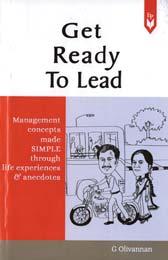

Getready to lead — a book that brims with positivity and motivation, it talks about aspects such as goal setting, skill development, time management, teamwork and social intelligence. Peppered with case studies and laced with humour, it makes an interesting read.
Talking about accountability, the author narrates his personal experience, when he had to delay informing his father’s demise to his printing unit staff so that the work committed to be delivered the following morning to a client was on schedule.
On teamwork and leadership, there is an anecdote of the 1983 World Cup finals when India crumbled with a miserable 183 runs for the West Indies to chase. Before going out to field for the second session, in the dressing room Kapil Dev, as captain, inspired his dejected team saying, “Team, if this is not a winning total, it’s definitely a fighting total.” When the Windies were short by 43 runs, India emerged World Champions for the first time.
The author G Olivannan is a past governor of D 3232. The book can be got from Emerald
Kalam Kids features:
• 31 unique PCB interactive lab simulations.
• A curriculum developed by scientists from Harvard, Cambridge, Imperial College, Danish and MIT, USA.
• Students can perform science experiments virtually
• Needs just a tablet or PC with internet connectivity.
• Ideal for students of Class 5 and higher levels.
• Special subscription package for Rotarians, government schools
For more details contact anupkarwa@gmail.com
Publishers, Chennai. Phone: 91 44 2819 3206/4214 6994. Email: info@ emeraldpublishers.com.
Do you know that the Shelter Box is the world’s largest Rotary project; it is affiliated in eight countries involving 5,000 clubs. In 1979, when the then RIPE James Bomar challenged Rotary clubs to make a non-Rotarian a PHF, by making a donation in his/her name, do you know that RC Pikesville, USA, responded by making a donation in the name of Mother Teresa.
Find such interesting information in this concise quiz book compiled by past presidents Narayana Shagrithaya (RC Mumbai Bhandup, D 3141) and Kanti Solanki (RC Thane Metro, D 3142). Rotarians can use it to enhance their Rotary knowledge or gift it to inspire a new member. The book also includes list of RI Presidents from Paul Harris to RIPE Barry Rassin, along with their themes, and other important abbrevations.
Priced at `100, the book is available with Narayana Shagrithaya –Mobile: 98212 67367/98209 67367 or Kanti Solanki – 98670 26464.
RC Bangalore, D 3190, created history of sorts this February by chartering a Rotary club which is exclusively for the differently-abled.
RC Bangalore President Zarir Batha said the 20-member club “has been in the making for more than eight months, and it is a day of great joy for us as we usher in this unique club.”
Notwithstanding the challenges you face, you have decided to join the battle for doing good in the world. You have come together not only to help people with disabilities but also all needy persons who require your help.
Addressing the new club — Rotary Bangalore Abilities — Batha said all the 20 members of the newly chartered club were “really special people. And if there is a word called courage, you exemplify it through your personal lives. Notwithstanding the challenges you face, you have decided to join the battle for doing good in the world. You have come together not only to help people with disabilities but also all needy persons who require your help.”
He added that his club, which had seen illustrious presidents like Homi Bhaba and PRID Panduranga Setty, had pledged to lend all support to the newly formed club to make it both vibrant and successful.
President of the new club, Justin Philips, who is the Editor of a braille magazine called Insight, said even as their new journey began, “we commit ourselves to following the culture and ethos of the Rotary movement.

From L: Rotary Bangalore Abilities Secretary Pradeep K, President Justin Philips, Treasurer Sravani
Ramachandran (extreme right) with Rotary Bangalore
I pledge to uphold and follow the rules laid down by RI. I also pledge to abide by the 4-Way Test.” A talented musician, the visually-challenged Philips gives lessons in playing the guitar and the keyboard; is a transcriptionist for market research companies and teaches English to global students using email and WhatsApp. Secretary of the club, Pradeep K, is also partially blind and is a software professional; and the treasurer, Sravani Ramachandran, a paraplegic due to an accident, is a financial analyst with the IBM.
RC Bangalore Abilities plans to take up four major projects: a campaign to sensitise the government and owners of small malls to make their facilities more disabled-friendly; a job fair for the differently-abled; a rural school for children with disabilities and sponsoring braille screen readers, each costing about `25,000.
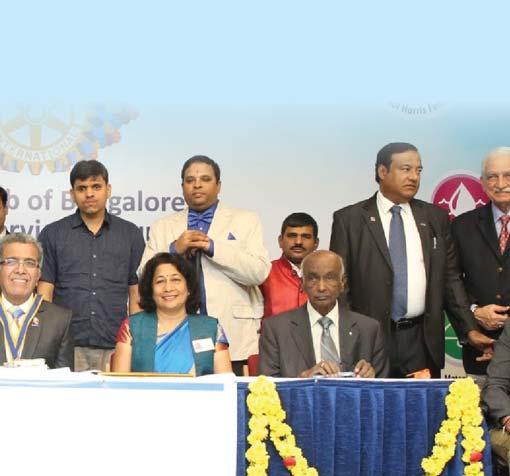
Secretary R Girish, President Zarir Batha, DG Asha Prasanna Kumar, PRID Panduranga Setty and other charter members of the new club.
PRID Setty and DG Asha Prasanna Kumar participated in the event.


Whatstruck us most was the warm hospitality and the grandeur of your celebrations,” said Isabel Regina Scheid, a visitor from Brazil. I am chatting with a four-member Friendship Exchange team from District 4670, Brazil, hosted by D 3000, on the sidelines of their District Conference in Madurai. While Isabel, the lone English-speaking visitor of the team is a veterinarian, Egidio Dallagnol, the Youth Exchange Chair, is a mechanical engineer, Cleiza Maria Alfaya is a teacher and Cristiane Dias a psychologist and an avid yoga trainer. The three women — Isabel, Cleiza
and Christiane — are traditionally dressed in blue silk-cotton saris, replete with jasmine flowers on their hair and a bindi adorning their foreheads.
At Pudukkottai, the Jallikattu event during the Pongal celebrations, fascinated them. “It was interesting to watch the wild bull being tamed by men and we found it somewhat similar to the Spanish bullfight,” said Isabel.
After ten days of soaking up the culture and traditions of Tamil Nadu, Egidio left for Brazil, while the three women proceeded to Delhi where they were received by
DGE Subhash Jain. They visited the Taj Mahal at Agra after touring Delhi and got some lessons in yoga in Rishikesh before leaving for their country.
“Throughout their sojourn across various small towns, the visitors loved the varied experiences; the temples, the local folk programmes and the grandeur of the Chettinad Palace hotel where they stayed, amazed them,” said P Kumarappan, District Friendship Exchange Chairman, who accompanied the foreigners on their tour. Attending his cousin’s wedding in a village and experiencing
Christiane Dias poses with a bull as Cleiza Maria Alfaya tries to click a picture at the Jallikattu event in Pudukkottai.
the Chettinad splendour was an added bonus for the visitors.
They were particularly impressed with the mental health mission project at Dindigul and the vocational training centre in Karur. Isabel recalled the Republic Day celebrations in a school in the small town of Vathlagundu. “We were surprised when the school honoured the Brazilian flag in addition to the Indian flag. These saris are a gift from the Principal to us.”

Cleiza enjoyed the ambience of Kadambavanam (a resort near Madurai) and the folk performances there. “I also
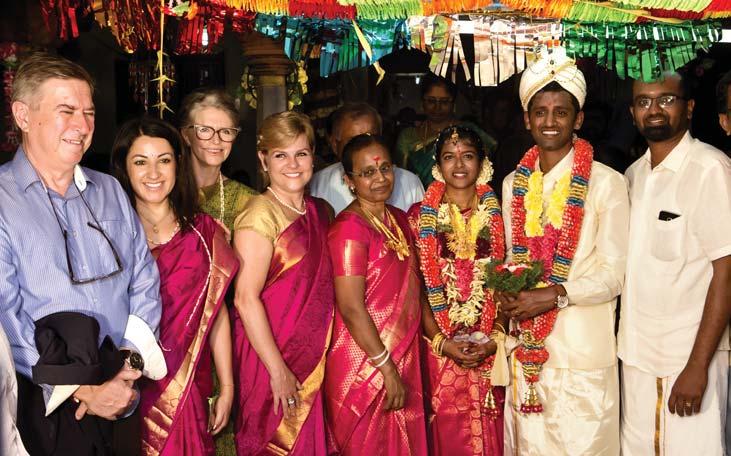
loved the plethora of flavours in the Indian cuisine and the experience of eating from a plantain leaf. It required some special skill,” she said in Portuguese, which Isabel translated. The members of RC Madurai Innovators had organised a special programme for the team at the resort.
Snorkelling and kayaking in Rameswaram made their tour more memorable.
A ten-member team led by Kumarappan is all set to leave for Brazil in May to experience their hospitality and culture.
Rotary Club of Poona, D 3131, recently sponsored a blood collection van, with support from Zylog plastalloys. The van, costing `35 lakh, is equipped with two deep freezers to store collected blood until it reaches the blood bank/hospital, and has the required inverters and batteries.
DG Abhay Gadgil handed over the van to Dr Ajay S Chandanwale, the Dean of BJ Medical College and Sassoon General Hospital, in the presence of PDG Vinay Kulkarni, DGND Rashmi Kulkarni and Club President Prakash Telang.
“We came up with this idea to mainly cater to blood donors living far away from blood banks or hospitals and who are keen to donate blood,” said Telang. DG Gadgil is happy that the Rotary-CSR initiative has fructified and is hopeful that more clubs will be inspired to replicate this project. “A lot of good can

From L: Anjali Telang, DGND Rashmi Kulkarni, RC Poona President Prakash Telang, PDG Vinay Kulkarni, Rajesh Bahl and District Medical Services Director Anil Parmar with the blood collection vehicle.
happen when corporates collaborate with Rotary to develop communities,” he said.
The 80-year-old club, chartered in 1936, has a long relationship with the hospital, having donated a human
milk collection van and various medical equipment for the paediatric ward. Telang invites Rotary clubs across Maharashtra to avail the services of the van for their blood collection initiatives.

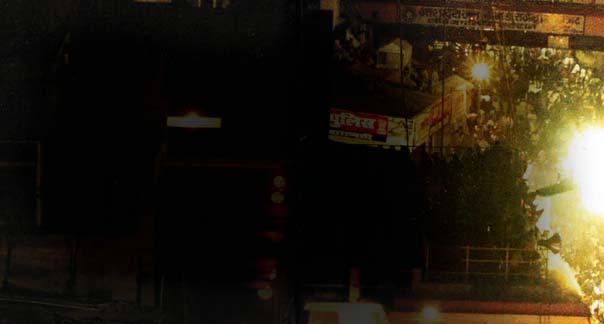












A glossy coffee-table book on the pilgrimage town of Varanasi titled The Book of Banaras brought out by Rotary Club of Benares, D 3120, during the tenure of the then DG Ved Prakash (2015–16) takes readers to a delightful tour of this colourful spiritual hub.


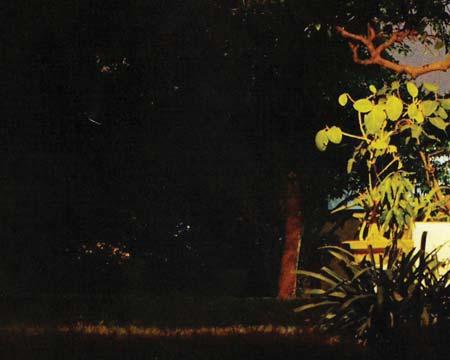





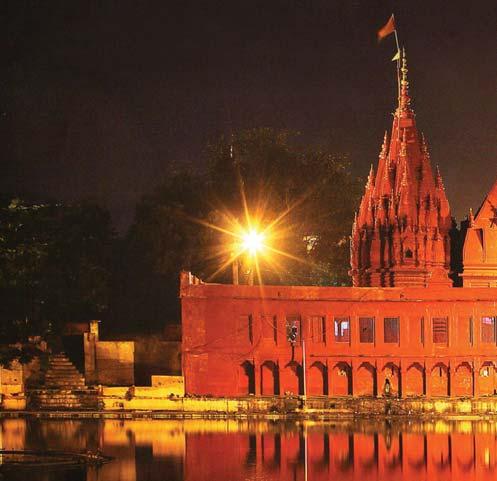


The 122-page book scripted by Dr Vishwanath Pandey with pictures and layout designed by Manish Khattry is a good reference point for Kashi, the oldest living city in the world. The Ganga Ghats, Sarnath, mosques, temples, fairs and festivals and the life of Banaras come alive on its pages.


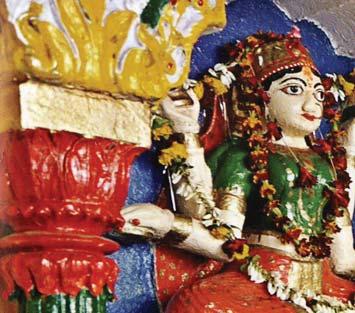


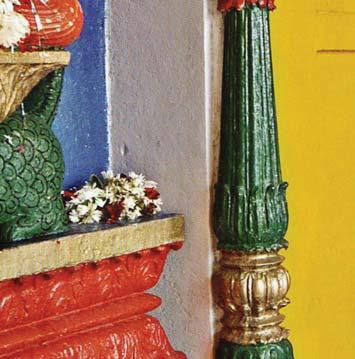












Kiran Zehra
Wearing their grey and white driver’s uniform and best smile, seven women received the keys to their brand new electric taxis at D 3190’s Rotary Karnataka CSR Conference at Bengaluru. Just before flagging off the taxis, TRF Trustee Chair Paul Netzel, walked up to each of them, shook hands and warmly wished them “all the best.”
Addressing the meet, he told DG Asha Prasanna Kumar, “What an innovative idea to introduce Rotary to corporates and other NGOs in your community. Congratulations to
you and your team.” He reminded everyone in the room that “the issue and opportunity for each of us is not money. Rather it is the opportunity we have been given to explore how we can work with each other and how Rotary can help you.”
RC Bangalore Orchards, partnering with transport logistics provider Bhagirathi Travels, have taken up a project to train women as professional drivers so as to help them get employment. Club member and co-founder of the service provider Neil Michael Joseph highlighted the uniqueness of the project — the focus on driving electric vehicles

TRF Trustee Chair Paul Netzel wishes good luck to a driver as PRID Manoj Desai looks on.
which helps check pollution. The club plans to train 500 women in car driving in the next three months.
Powered by STEM Learning and supported by TSMT Bengaluru, and with India CSR Network as a knowledge partner, “this conference is the first-of-its-kind in D 3190, and will be an annual event,” said DGN Sameer Hariani, adding that the conference had got 170 delegates.
While the event was organised to celebrate the contributions made by various stakeholders and corporate houses towards community service in Karnataka, DG Asha said some of the
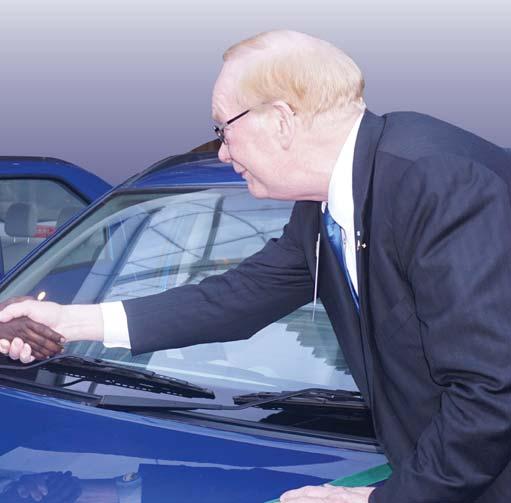




From L: PRID Panduranga Setty, TRF Trustee Sushil Gupta, TRF Trustee Chair Paul Netzel and PRID Manoj Desai at the CSR Meet in Bengaluru.
speakers had travelled from Delhi and Mumbai on their own expense “just to see how they can collaborate with Rotary and find solutions to India’s most challenging problems in the areas of education, healthcare, environment and skill development.”
Rotary, the umbrella organisation
Representatives from various foundations and companies like Philips, IDFC Bank, Azim Premji Foundation, Capgemini, Embassy, NALCO, Mindtree Foundation, JSW Foundation, Tesco Bengaluru, Bosch India Foundation, Adobe, Brillio, Cognizant and ANZ participated in various panel discussions related to education, skill development, health and sanitation, green Karnataka, and rural development. Collaboration, transparency and accountability were the keywords of every session.
PDG K S Nagendra who moderated the session on rural development stressed that “we need to move beyond the cheque and ensure that CSR partnerships engage in planning strategies
and focus on the impact that we can collectively make.” Sumathi A Rao, Director, PR and Sustainability, Philips, said “Together we can create a larger impact. All we need is an umbrella organisation that can bring together individual foundations.” DGN Hariani quipped: “That umbrella organisation is in this room — Rotary.”
While Archana Sahay, Head of CSR, Thomson Reuters, recalled her “wonderful days as a Rotary exchange student”; Arun Nathan, Programmes Director, IDFC Bank, said, “As a Rotaractor, I learnt a lot and its time to give it back to Rotary and do good.” When asked if they were Rotarians, Archana replied “Not yet.”
Rotary Corporate Awards were given to Bosch India Foundation, Bhagirathi Travels, Cognizant Foundation, Goldman Sachs, Intel India, Jeep, Karnataka State Electronics Development Corporation, Oracle India, TCS and Thomson Reuters for their contribution towards doing good in the world.
PRID Manoj Desai said “Today, I have learnt a lot about CSR and the
expectations of the corporates.” He gave highlights of the TEACH and Asha Kiran initiative that have earned Rotary India a partnership with the Kailash Satyarthi Foundation. PRID Sushil Gupta emphasised on the need for ushering in behavioural change in the entire community and introduced the audience to Rotary’s WASH initiative.
Addressing corporate heads, Netzel said, “the CSR opportunities in India are great and the values of Rotary and CSR are compatible.” Without marginalising any of the other “wonderful foundations and humanitarian organisations in the world,” he described why Rotary is an exceptional organisation and a great partner. “Unlike any other organisation in the world, we have a global reach in 200 countries, with 35,000 clubs and 1.2 million Rotarians. In almost every community in the world, there is a Rotary club, which has great diversity by almost any definition you can come up with.” If any

of the corporates present in the room joined hands with Rotary, they must know that “Rotary has the capacity to access and serve as a major connector with thousands of volunteers, civil and government leaders at the highest level. Ours is a simple organisation and we have proved our ability to be a partner, collaborator, advocate, but most of all, we have demonstrated that when we make a promise, we keep it.”
Defining TRF as a “sacred trust with 15 committed trustees from around the world,” he said the philanthropic arm of Rotary is responsible for raising funds, awarding scholarships and grants. “In the last 100 years, Rotary has raised and invested $4.3 billion. This is to tell you that we have well-defined goals and will be doing and supporting many humanitarian projects in the coming century.”
Netzel added, “Perhaps the biggest initiative that speaks so well about Rotary’s capacity to do things is the
Ours is a simple organisation and we have proved our ability to be a partner, collaborator, advocate, but most of all, we have demonstrated that when we make a promise, we keep it.
TRF Trustee Chair Paul Netzel
End Polio initiative.” Recalling the journey from 1985 when Rotarians launched the Global Polio Eradication Initiative after raising $247 million in two years, he said that the impact of Rotary’s work in the End Polio drive was so powerful that in 2007 the Bill and Melinda Gates Foundation said: “We want to join you.”
While this year may perhaps see the last polio case in the world, it will still
take another 36 months for the world to be declared polio-free. “How are we going to keep the interest of Rotarians and stakeholders in this programme for 36 months is the question,” he said, urging Rotarians never to lose focus on this aspect. Netzel stressed on the need for world peace and said, “As we sit here this evening, 1,052 Rotary Peace Fellows are out there promoting peace in some of the most unstable parts of the world.” Pointing out that Rotarians have to choose their projects carefully, he concluded the conference by quoting Bill Gates Sr., who said “I have spent the last decade travelling around the globe thinking of monstrous problems. It boggles the mind to try and make sense of how dramatically you Rotarians have changed millions of lives. When the time comes to deciding on the next global programme, Rotary needs to think big, anything less will be a waste of Rotary’s potential.”
Pictures by Kiran Zehra
We are moving: RI South Asia Office is shifting to a new office location near Indira Gandhi International Airport, New Delhi, effective April 16. The new office address is:
Rotary International South Asia Office
Pullman/Novotel Commercial Tower 1st Floor, Asset No.2, Hospitality District
Aerocity (Near IGI Airport), New Delhi 110037
The telephone/fax numbers of office will remain same: Telephone nos: 91 11 42250101 to 42250105. Fax: 91 11 42250191 and 42250192
If you happen to be in Delhi after April 16 2018, please do visit us at our new office location.
Current club officers must report the incoming club officers to RI on priority. We still have large number of unreported club officers. Reporting can be done online through My Rotary or by e-mail to data@rotary.org.
Group Cultural Exchange programme is a type of Rotary Friendship Exchange that brings together international teams of Rotarians, non-Rotarians and young professionals. Contact your district’s Rotary Friendship Exchange Committee Chair for
more information about exchange opportunities through your district. If you have questions, or an experience you’d like to share, contact rotary.service@ rotary.org.
Tree Planting challenge - It is perhaps the best time to plant your club’s trees. Not only is planting trees one of the best things you can do for the environment, it also brings you one step closer to your Rotary Citation. Be sure to plant your trees by April 22 (Earth Day) and take care of the trees you’ve
planted until they’re thriving on their own.
Global Grant reporting: The Rotary Foundation has noticed that the clubs/districts have submitted the required Interim reports/final reports online. Please note that online submission of the reports alone does not mean that the report is accepted/grant is closed. As per the reporting requirements, the clubs/district will have to submit supporting documentation in order to accept the Interim report or close the final report by the Foundation.
Below is a chart showing supporting documents required to be submitted in originals to the Foundation along with the online report submission:
Submit report online YesYes
All original hard copies of the following documents required
Original Utilisation Certificate and receipts/payment statementYesYes
Bank statement in original/certified true copyYesYes
Bills/invoices/receipts in originalNAYes
Undertaking (if copy of the above submitted)NAYes
Beneficiary informationNAYes
Refund, if anyNAYes
Grant Reporting Deadline –
Kindly submit interim report of activities upto March 31, 2018 of all open grants positively by May 31, 2018 . Otherwise the Grant will become overdue on reporting effective June 1, 2018. New grant applications will not be accepted by the Foundation if a grant
sponsor has an overdue report for any Foundation grant. To know more about reporting requirements and the requisite formats, click on link http://www.rotaryfoundationindia.org/reporting/ Applications for the 2019–20 Rotary Peace Fellowship programme are now being accepted. To learn more about Peace
Fellowship Application, click on link https://my.rotary.org/en/ peace-fellowship-application. The deadline for applicants to submit applications to their district is May 31, 2018. Districts must submit endorsed applications to The Rotary Foundation by July 1. For queries, please write to rotarypeacecenters@rotary.org.

V Muthukumaran

Ever since its inception in 1968, the Rotary Club of Moodbidri, D 3181, has been doing yeoman service by installing facilities and structures for the social and economic development of Moodabidri, a small town in Dakshina Kannada. A number of structures such as a radio pavilion, bus shelters, parks, classrooms, school furniture, Rotary toilets, lakes and blood bank are telltale symbols of the club’s intimate connect with the people here.
The club is the brainchild of Dr TMA Pai, the architect of modern
Manipal, who along with other visionaries, laid the foundation for the social transformation of this small town way back in the 1970s. The ongoing projects such as health camps, eye camps and mass marriages are well-appreciated by the public, thus greatly enhancing the public image of Rotary in Moodabidri.




Till 1981, the town did not have an English medium school and Rotary stepped in three decades ago to establish the Rotary English Medium
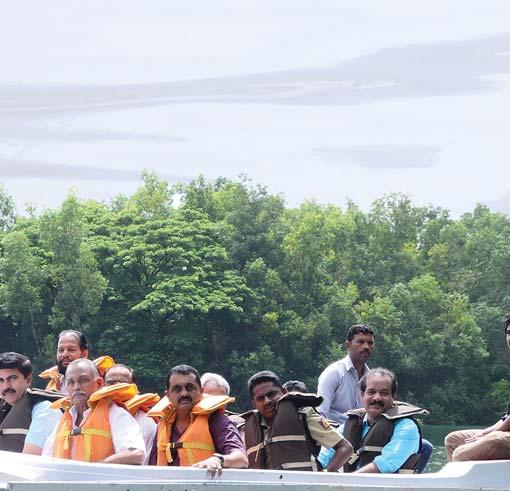
School, with the financial backing of the club members. Though it was not economically viable initially, the generosity of the members made it sustainable. With an investment of more than `25 crore, the school has grown into a huge institution today catering to 2,500 children from Kindergarten to secondary grade. The club later came up with the Rotary Central School, following the CBSE syllabus. With emphasis on holistic development of students’ personality and values, the schools have a record of




securing 100 per cent results in public exams each year, says Club President Srikanth Kamath.
Having to contend with an expanding township, the club came to the rescue of people when they suffered from water shortage a decade ago. The ‘Rotalakes’ project took shape with financial support from the famous Manjunatha temple in Dharmasthala and the State government. About `1 crore was spent to rejuvenate Kadalakere, a huge lake.
“So far, we’ve desilted and restored two major lakes; this year, we will



The club has constructed 100 toilets so far at an overall cost of `25 lakh, and 100 more are in the pipeline. We’ve desilted two lakes; our target is to restore all the 18 lakes in and around the town.
Srikanth
Kamath President, RC Moodbidri


complete two more. Our target is to restore all the 18 lakes in and around the town, ” says Kamath. A tentative amount of `3 crore has been earmarked for Rotalakes.
Toilets for the poor
Project Rotalet was launched in 2015 to provide toilets cum bathrooms for rural, deprived families in and around the region. The club has constructed 100 toilets so far at an overall cost of ` 25 lakh, and “100 more are in the pipeline,” says the Club President. The Rotary toilets are much appreciated by the government and the media has given wide publicity to these projects.
To mark the golden jubilee milestone, the club inaugurated a blood bank worth `70 lakh recently. “We want to give something substantial to society as a remembrance of the celebrations,” says J J Pinto, a club member.
“We have come a long way since inception with a present membership of 87 active members and three charter members. This includes three major donors and 57 Paul Harris Fellows,” says Kamath. He is confident of the club achieving the target of $5,000 in TRF giving, of which $3,000 has already been collected.
Designed by N Krishnaurthy

V Muthukumaran
New, innovative means of doing good such as adopting IT platforms and systems must coexist with traditional ways of executing service projects. This is one of the six pet themes of RI President Ian Riseley who has formed an eight-member Task Force consisting of young PDGs blessed with clear perspectives on Rotary’s future, PRID Mikael Ahlberg, the RI President’s Representative, said at Vannangal , the district conference of D 3232.
Spelling out President Riseley’s vision and roadmap to make Rotary
a highly visible, relevant entity that transforms societies, Ahlberg added:
“First, Ian wants all clubs to record two numbers — man hours spent on projects, and the cumulative money spent in all.” Next came membership, which is critical for growth and here the focus must be on inducting women and younger members who can usher in positive change. “We also have to revitalise Group Cultural Exchanges which can replace GSE for promoting friendship across borders. And, if we want a sustainable life on the planet, each Rotarian must plant a tree… about 1.2 million new trees in a Rotary year.”

Clockwise from L: Sujatha, DG R Srinivasan, RID Mikael Ahlberg and Charlotte arriving at the District Conference venue in Chennai.
District governors and club presidents must hold training sessions for the newly inducted office-bearers on a regular basis. It is unfortunate that these programmes are not given due importance, said RI Director C Basker. Instead of holding such training sessions in foreign locations and office-bearers getting onto a ‘holiday bandwagon’, “we will hold such meetings within the district henceforth.” Asking pointed questions — whether

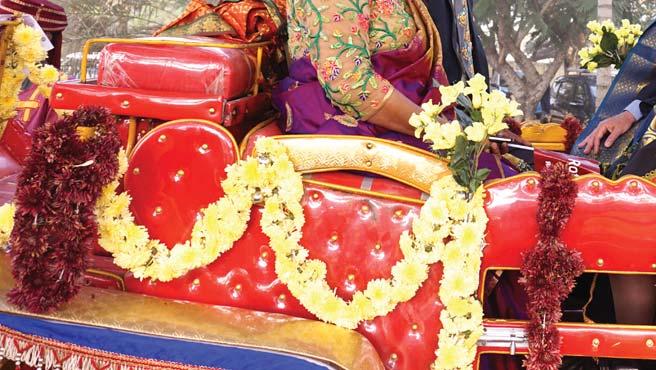


club meetings are purposeful; if action plans are being drawn up; and follow-up work is being taken up — he remarked, “Instead of service orientation, club members are more interested in elections nowadays.”
Striking a sombre note, he recounted his interaction with late Sam Owori. When Basker proudly said that India accounted for 10 per cent of Rotary membership, instead of applauding the RID, Owori told him that when India has a population of over 1.2 billion, why couldn’t Rotary get one per cent of it as its members. After all Sweden has one per cent of its population as Rotarians. That had got him really thinking hard, the RID said and urged Rotarians to induct deserving, well-qualified friends and professionals into Rotary. “Club presidents must take up social and community projects following interaction with their members at regular meetings,” he added.
$100 to TRF
It is the duty of club presidents to explain the charitable projects and other activities of the Foundation to
Your contribution to TRF will either feed a sick child in Somalia, help a destitute woman in the Philippines or rehabilitate a drug victim in Guatemala.
RI Director C Basker
their members before urging them to contribute to TRF. With gentle persuasion and convincing talk, “every Rotarian can be made to donate at least $100. For they must know, that their money will go to either feed a sick child in Somalia, help a destitute woman in the Philippines or rehabilitate a drug victim in Guatemala. All their money is going to a good cause.” Conference Chairman Selvam Alagappan from RC Chennai East R A Puram was felicitated by the RI Director.
Rotary, Apollo tie-up Rotary will partner Apollo Hospitals to deliver healthcare in rural areas through vans, ambulances and other vehicles donated by companies, said PRID P T Prabhakar in his address.
Apollo Hospitals Chairman Dr Pratap C Reddy said that avoidable mortality is a cause of concern and “the 80,000-strong Apollo family will join hands with Rotary to stop the tsunami of NCDs in the rural areas across the country.” Noncommunicable diseases (NCDs) such as diabetes, cardiac-related illnesses, stroke, blood pressure, cancer and hypertension kill 6,000 people a day in the country, he pointed out.
DG R Srinivasan detailed the various service projects performed by the district Rotarians. This is the maiden district conference of the bifurcated D 3230. So far, 10 new clubs have been formed this year and training was being extended for club leadership in an extensive manner, he said.
Addressing the conference, State Minister for Tamil Language and Culture K Pandiarajan urged Rotarians to become mentors of farmers
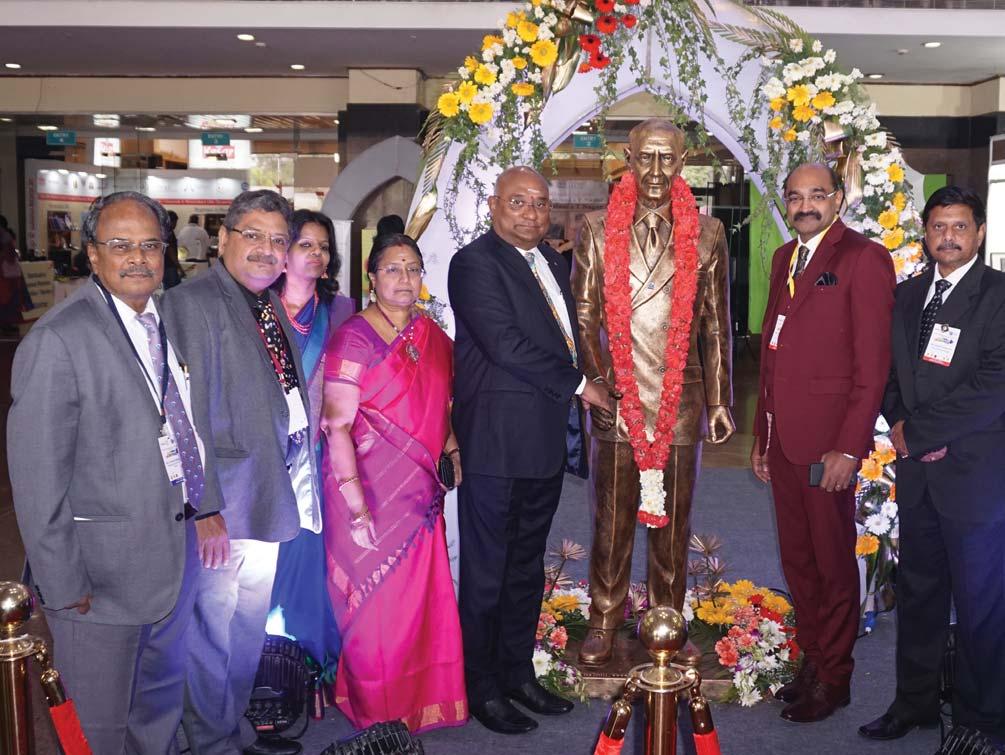
in an ambitious project of the government which aimed to transform the rural landscape at an estimate of `6,400 crore.
The idea was to form clusters of 25–30 farmers each and develop entrepreneurial skills in them so that they don’t need to depend on farming alone for livelihood. “We can, by this approach, create over 12,000 small to midcap rural firms in this World Bank-funded project. Rotarians can put their intellectual capacity nurtured through service domains to good use by joining as mentors,” he added.
The conference began with DG Srinivasan, spouse Sujatha, RIPR Ahlberg and spouse Charlotte alighting from a horse carriage which was followed by a caravan of 30 vintage
cars having club presidents and district officers.
In the procession were 13 floats depicting the District’s signature projects, and Rotary vehicles like those being used for blood banks, ambulances and mobile health camps.
A life-size statue of Rotary Founder Paul Harris was unveiled by Ahlberg. It is similar to the one at the Rotary headquarters in Evanston, Chicago and was created by the National award winning sculptor Munuswami. The statue was sponsored by RC Madras Metro.
Another highlight was the display of Room 711, sponsored by RC Madras Pallava, that replicated the modest room in which the first meeting of Rotary was held way back in 1905 in Chicago.
Rotaractors brought a dash of colour and rhythm with a march past holding the flags of 219 countries where Rotary is present and 11 Rotarians who are honorary consul generals in Chennai were felicitated.
Former cricketer Syed Kirmani presented the Icon of Chennai Award to off-spinner R Ashwin in the presence of Rotary leaders. Also, film actor and mimicry artiste Jayaram was feted with a Rotary award for acting in more than 200 films over three decades.
Above 2,500 Rotarians had registered for the conference including 38 Rotarians from Kenya, 25 from Australia, 18 from Belgium and seven from Canada.
Pictures by V Muthukumaran

action action people people of
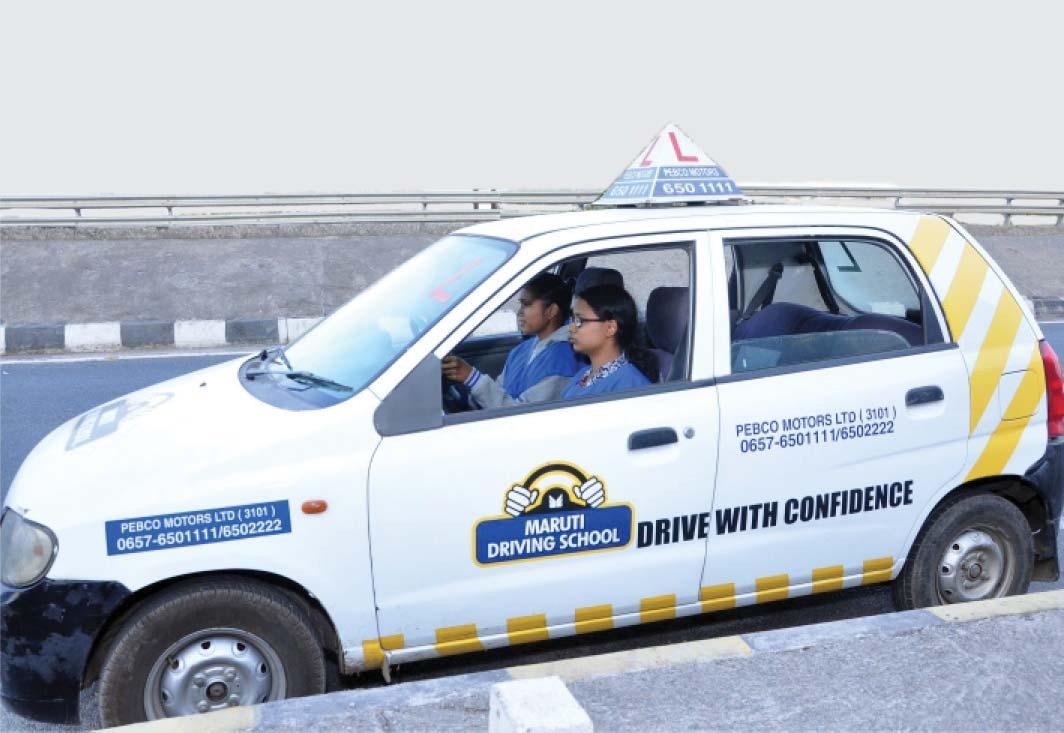
The Rotary Club of Jamshedpur Steel City, D 3250, has tied up with Pebco Maruti Driving School, to train women as professional drivers. “The income opportunities here for women car drivers are aplenty. Parents are comfortable and consider it safe to send their young daughters with women drivers to school and office. We hear that Uber and Ola are planning to recruit women drivers too ,” says Alpa Parikh, the Club President.
Initially, six young women were enrolled for the classes. “Jamshedpur has migrated population from nearby adivasi communities, who are
employed in companies like Tata Steel. The women are engaged as household maids or maalis. We identify these women or their children for the course,” says Club Secretary Parnika Agrawal.
The driving school provides extensive classes in theory and practicals, including simulation and on-road driving. “The first day when I sat on the wheel I was mighty thrilled. I felt like I was flying an aeroplane,” say Rupa Nag, a student.
“I am now driving my uncle’s Alto. Everyone in my family, especially my mother, is so proud of me. It’s all like a dream for me,” says another student Lakshmi Rani Singh.
DG Vivek Kumar distributed the course completion certificates to the women. “Two of the students have got employment with a Tata Motors dealer here,” says Parnika. The club is all set to start the next course.
Each class is of 40 days duration. A nominal fee of ` 1,000 is collected from the student to ensure their commitment to the course. The club bears part of the fee of `4,500, says Parnika. The school coordinates with the RTO to get the driving license for the students. The girls can enroll for additional classes if they need more training or until they get the confidence to drive on the roads independently.
Jaishree

Ata government school in the scenic Madikeri in Coorg, students of Classes 8, 9 and 10 are excited. Some of the boys quickly brush up their chemistry, biology and physics lessons with great enthusiasm. The reason: they are all set to receive the mobile science van, the Vignana Vahini, and the teachers are going to bring in the various apparatus — the burette, pipette, conical flask, test tubes — for experiments to make salt out of copper and sulphuric acid; show how a thermostat works and all that the children have been imbibing through the printed word for so long.
The school does not have a science lab and the van is a boon for the students. Three such vans, housing mobile science/math labs, are an initiative of the Rotary Club of Madikeri Misty Hills, D 3181, with support of a global grant funding from The Rotary Foundation and the Rotary Club of Central Chester County (Lionville), D 7450, Philadelphia.
The Rotarians got this idea from the Swami Vivekananda Youth Movement (SVYM), an institution in Mysuru, which specialises in rural education. It operates four such vans around Mysuru. “We also consulted
teachers and officials from the education and science and technology departments. We wanted to give the children a hands-on experience in science and math lessons so that they develop and sustain interest in the subjects,” says K K Vishwanath, the Project Contact for the club. These subjects can be interesting only when the concept is seen and clearly understood, he adds.
The vans will do the rounds across 99 identified schools in Madikeri, Somvarpet and Virajpet, covering about 15,000 high school students. They will visit each school four times action action people people of

This is an engaging way to interpret science and create a love for math in the children.
K K Viswanathan Project-in-charge
a year and facilitators, selected and trained by the SVYM, will take the lab to the classroom. The school teachers will also be trained in this programme. Each van, a Maruti Eco, is equipped with a projector, UPS, batteries, laptop and a 250 ft cable. “Our staff check with the school about the lessons being taught presently and based on that input, they take the equipment and material,”

Facing page: A science experiment in progress in a classroom.
Left: math lab.
says Vishwanath. A house has been rented in each of the mandals to park the vans, and store the lab equipment and material. Then the van visits the schools in that mandal. “We have involved all the clubs in the district to monitor the vans going around the schools in their area; a past assistant governor takes care of the overall administration for each van.”
The total cost of the project was $35,000 while the operational cost works to ` 10 lakh annually. This is borne by the SVYM. “We have received amazing feedback from the schools within a year of its inauguration. This is an engaging way to interpret science and create a love for math in children,” says Vishwanath.
Club of Jammu Elite, a newly chartered all-women’s club of D 3070, has launched a short film to create awareness on water conservation. The five-and-a-half-minute video, produced by the Club President Nupur M Sandhu, was recently released at the Raj Bhavan by J&K Governor N N Vohra.
“The film has been screened to nearly 15 lakh students with recommendation from the State Education Department,” says Nupur. It is set in the backdrop of an NCC training campus. “The inspiration from the film may be two-pronged — while addressing the need to preserve water, it may also inspire schoolchildren to get trained as NCC cadets and it will help instill better discipline,” she adds.
The video was screened at the District Conference and was lauded by PDG Emmanuel Katongole, D 9211, Uganda, who was the RI President’s Representative at the event.
Kiran Zehra
Bifurcated from D 3230, D 3231 hosted its first District Conference recently. It had an attendance of over 3,500 Rotarians. PDG Siri Eiamchamroonrp from D 3340, Thailand was the RI President’s Representative. Conference Chair M Srinivasan and PDG SvRm Ramanathan (D3232) worked hard to transform a thorny field at Ambalal Greenfield in Vellore into a 1,00,000 sq ft lavish, fully air-conditioned auditorium.
The venue was designed to look like a palace; the entire set took six months, 250 artisans from Mumbai, Hyderabad and Delhi and `2.25 crore to be completed, said Srinivasan. He added, “We could have easily chosen a hotel or any other readymade venue. But we wanted
the event to be memorable.” Sangeet, the dance show, exclusively performed by 300 Anns and Annets was a big hit. Guest speakers such as Mahatria Ra, Jayanthasri Balakrishnan, Anbumani Ramdoss and Tamil film director Bharathiraja spoke about service and women’s empowerment and thanked Rotary for the good work it is doing.
The Abirami Awards, sponsored by Abirami Mega Mall, celebrated and honoured the work of Tamil artists from the entertainment industry, taking into account the entertainment quotient they provided. The event was attended by actors Prabhu, Sai Dhanshika (Kabali fame), Sharatkumar and Radhika. “The celebrities entertained us; the audience lapped it up and the show went on till the wee hours,” said Srinivasan.

Apart from planting 25,000 seed balls, conducting medical camps and creating awareness on AIDS, cancer and dengue, D 3231 is also funding the construction of 164 homes for the Narikuravars (gypsies) in Ambur and Kallikupam villages on the outskirts of Chennai. Each home is of 300 sq ft and includes a bedroom, hall, kitchen and a toilet and costs `3 lakh. “We don’t just spend money on events. Our projects are proof that we carry class in everything we do,” he said, adding that “we have set ourselves a benchmark and hope to be able to keep it in the years to come.”
Thanking his core team for the success of the conference, DG Jawarilal Jain said, “Without their support and all the hard work, this would have never been possible.”

Tamil film director Bharathiraja felicitates PDG Sv Rm Ramanathan and spouse Nallammai in the presence of their daughter Meenakshi Perikaruppan and film artiste Jayachitra at the Conference.

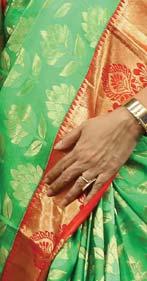

To bridge the wide gap between urban well-to-do schools and underprivileged tribal schools in remote areas of Maharashtra, RC Nasik, D 3030, has initiated a global grant project in partnership with Lewisville Morning Club (D 5790, Texas). A global grant committee, formed with 70 Rotarians and chaired by Nitin Pathak, visited the schools around Nasik to study the reality in rural classrooms. They came up with a solution to provide five major components comprising basic study material for students, e-learning facilities, teacher training, adult literacy and setting up libraries in schools.
The donor club from the US went into every detail of the project and even vetted the electricity bills of the beneficiary schools to ascertain the genuineness of their claims. A representative from that club, Caroline, visited Ghoti and felt satisfied with the need for such a project in these schools. The club received a grant of $40,000 last year when Anil Sukenkar was the president.
The ‘CAFÉ (Child Adoption For Education) Kit’ consisting of two pairs of uniforms, socks and shoes, five notebooks, a water bottle, school bag, geometry box and a pencil box were distributed to over 1,000 students in 23 schools of Ghoti village near Nasik, says club member Mangesh Apshankar.
The club distributed e-learning kits to 40 schools, organised two training programmes for teachers and is in the process of setting up libraries in the identified schools.

The fourth component, adult literacy, has been taken up by initially training the teachers in village schools. “A report will be submitted to the donor club and RI too will closely monitor the impact of this part of the project activity for at least three years through official visits and field documentations,” says Apshankar. Forty-four Interact and eight Rotaract clubs regularly take up adult literacy projects and teachers’ training in these schools.
Lack of basic amenities like teaching tools, shoes, books, uniforms etc should not come in the way of acquiring education.
Radheya Yeole President-elect, RC Nasik
“The idea is to offer a level-playing field to all. Lack of basic amenities like teaching tools, shoes, books, uniforms etc should not come in the way of acquiring education,” says Project in-charge and President-elect Radheya Yeole.
Thalassaemia camps
Thalassaemia camps were held in the Pune Vidyarthi Griha School in Nasik and Ashram Shala in Dhondegaon, in association with the Nashik Centre of the Parent Association of Thalassaemic Unit Trust. Of the 600 children screened in both the schools, 15 were found to suffer from thalassaemia minor, five from sickle cell disease and 196 were found to be anaemic.
The parents of the affected students were given counselling. The Rotarians advised the school management to adopt simple changes in their meals to make them more nutritious.

V Muthukumaran
Banking on its earlier experience in running a vocational centre for the last 19 years, RC Madras East, D 3232, has now inaugurated a second centre for skill development at Thoraipakkam, on the outskirts of Chennai, with an aim to equip underprivileged youth to lead a decent life.
The former centre in Bhemmannapet Community College delivers hands-on courses on bakery and confectionery; para medical; lab assistant;
computer hardware-cumtally; and spoken English. Over 1,100 students have passed out of the centre with about 90 per cent of them employed in various offices.
The Club President B S Purushottam highlights the success story of Kavitha, a school drop-out. Her father was working as a scavenger with the Chennai Corporation earning `2,000 a month.
“Kavitha spent six months learning the software course offered at the centre, and topped it. Our
industry partner for the course provided her with a placement and today, after 10 years, she is earning more than `90,000 a month. She has provided education for her siblings and her family members are self-sufficient and pursuing their dreams. This cascading effect of skilling underprivileged sections and providing them employment has been our focus area. She has today become an evangelist of our programme and it’s our aim to create more Kavithas for our communities.”
The new centre at Thoraipakkam is founded on the principles of “placing scarce resources within the reach of the needy. After analysing the demand data, we found that there was a great need for trained personnel in the areas of plumbing, tailoring and software development,” he says. These courses will be taught with the help of industry partners such as Kohler, Grundfos, Indian Terrain and FreshWorks. Each discipline will train 150 students over a one-year period and
RC Madras East President B S Purushotham (second from R) honours State Minister for Tamil Language and Culture K Pandiarajan in the presence of (from L) Club Secretary Paparao Nalluru, IPP K Ananth and Vocational Service Director S Parameswar.
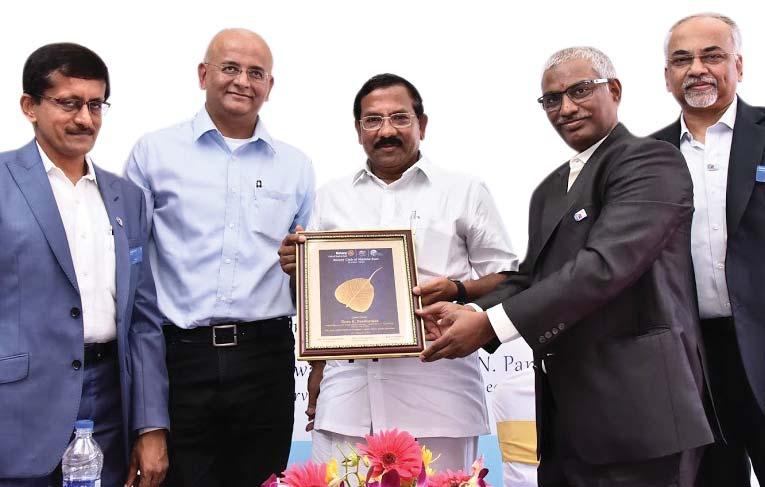
supplementary courses like spoken English, Etiquette and Ethics at Work Place will be taught to shape a well-rounded individual.
Lauding the club for its initiatives, the State Minister for Tamil Language and Culture K Pandiarajan assured the State government’s support in the club’s activities in reaching out to the underprivileged sections of society.
RC Madras East has spent `35 lakh for the infrastructure at the new centre, but the total investment would be around `1 crore, says Purushotham.
A special focus towards value-based education is

provided by Mahindra Pride for the candidates to develop “loyalty towards employers with a customer-focused work ethic that seems to be a rarity in today’s youth.”
This attempt will ensure that employers return to the centre to recruit skilled youth in their enterprises.
Four Rotarians from Canada and Italy, including PDG Bill
After you land at Pearson International Airport for the 2018 Rotary International Convention in Toronto, from June 23 to 27, there are many ways to get into the city.
You could take a taxi or airport limo. If you want to tour the area on your own, you could rent a car. But you could also save money by taking the express light rail train or public transportation.
The Union Pearson Express departs from the airport for Union Station every 15 minutes. A round-trip ticket for the 25-minute ride is CA$24.70; seniors pay half that amount.

You might instead take one of the buses run by the Toronto Transit Commission (commonly known
Gray from Rotary Club of Cataraqui-Kingston, visited the new training centre and were impressed by the facilities created to equip the students with need-based skills.
as the TTC). The 192 Airport Rocket will get you downtown in 45 minutes.
The TTC includes a vast system of buses, subways and streetcars. You can use all these services during a one-way trip as long as you have a paper transfer. Each trip is roughly $3, less for seniors and students, and can be paid for through cash or token.
If you plan on exploring Toronto during the convention, you can buy a pass that provides unlimited travel around the city for a day ($12.50) or a week ($43.75, seniors $34.75).
To register, go to riconvention.org. © The Rotarian

Imagine your world without Dr Zhivago and Madame Bovary and the poems of Rabindranath Tagore, Pablo Neruda, Hafez and Omar Khayyam. Imagine if only Germans could read Das Kapital and you had to know Chinese or Vietnamese to read Ho Chi Minh’s Prison Diary. As for The Art of War by Sun Tzu, who’d have even got a whiff of it apart from the Chinese? Of course, the English-speaking world would have been acquainted with Jane Austen and Shakespeare, but they’d not have had the least idea of the Panchatantra and the Kathasaritsagar. The Ramayana, the Mahabharata, the Illiad, the plays of Aeschylus and Henrik Ibsen and August Strindberg and Kalidasa. Why, even the Kamasutra would have remained unknown. Only Swedish children would have delighted in Astrid Lindgren, while being oblivious of Enid Blyton and her band of young

Sandhya Rao
Some thoughts on translations and how they bring the world closer together.
adventurers. Without access to the Quran , the Bible , the Bhagavad Gita , the Guru Granth Sahib , the Talmud, we would be the poorer and unenlightened.
Think about it. It would have been a sad story, a sorry world, in which we could not savour the good, and the bad, of all that’s been written. Freedom lies in being able to access all of this, and in continuing to walk through open doors leading to all the books that continue to be written wherever languages are spoken and shared, because that’s where ideas and emotions and contemplations emanate from. That is the source of our intellectual sustenance and our heightened sense of living.
These thoughts spring to mind because resting on the desk in front of me is a thick, elegant, hardbound book titled Bengali Culture Over a Thousand Years by Ghulam Murshid. Originally written in Bengali and published in Dhaka in 2006, its first English translation is just out. The translator is Sarbari Sinha who — to my great good fortune — happens to be a friend. However, despite the emotional reasons for reading the book, its 644-page length was a little daunting. Therefore, it lay inside my drawer for a couple of days until one evening I pulled it out, and opened the first page, skipping the
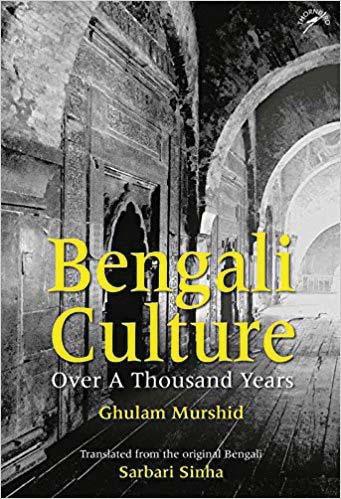
translator’s note — sorry, Sarbari — entitled ‘The Beginning’.
“When the Greek king Menander met the Buddhist sage Nagasena, the latter asked him, ‘Maharaj, you have come in a chariot. But what is a chariot?’ In reply, the king explained that a chariot was a vehicle on wheels drawn by horses. The sage asked, ‘Is the horse the same as the chariot, then?’ ‘No,’ said the king. Were the wheels the same as the chariot? No again, and so it went. If it is so tricky to come up with a definition of a chariot, it may seem virtually impossible to define a culture.”

Lucid, simple, beguiling, engaging — with an introduction like this, I couldn’t but read on. Of course, I’m going in fits and starts, rather like a train journey, taking short and long breaks depending upon the station, but moving steadily onward. Its overarching vision is fascinating. Murshid, a former professor of Bengali, writes in the afterword: “Bengali society is endlessly divided, the two major stakeholders being Hindus and Muslims. Historians have written either histories of Bengali Hindus or Bengali Muslims, not comprehensive works covering the shared destinies of the entire Bengalispeaking people.” Now, thanks to this English translation, my eyes are opened to this perspective.
Translation is an art. Translating is blood, sweat and tears. As Faiz Ahmed Faiz famously said, “The first rule of translation: make sure you know at least one of the bloody languages.” But that’s just the first step. To many, this is a false step. They believe that the very act of translation is to interfere with the sanctity of the text. There’s even a proverb in Italian which says, “ Traduttore, traditore ”. In English, “Translator, traitor.”
The story behind this saying harks back to the centuries-old cultural rivalry between the Italians and
the French, and the extreme sense of betrayal experienced by the Italians of the French translations of their beloved poet, Dante (1265–1321). They felt the French had not done justice to the poet, nor rendered him accurately. Dante Alighieri, to give him his full name, wrote during the early Renaissance period. His work, Divine Comedy — known as Comedia and later, Divina, in the mother tongue — is considered the greatest literary work in Italian, and is believed to have influenced many writers, particularly in the English language.
Sometimes, though, you don’t have to travel very far to pick holes in translations, let alone cross borders. Rabindranath Tagore, for instance, wrote in Bengali, of course — divinely and prolifically. And when he wasn’t writing poems, he was painting. Or he was writing novels and plays. He was one of those unbelievable persons for whose existence humankind is eternally grateful. But even he was not the greatest translator of his own work into English.
At a book release function a couple of years ago, writer Gulzar commented that Tagore’s works in other languages are not as beautiful as the original Bengali. A report in the Indian Express quotes him as saying, “Translation is not only about displaying a meaning in another language. A language carries a complete culture. The culture of

Without access to the Quran, the Bible, the Bhagavad Gita, the Guru Granth Sahib, the Talmud, we would be the poorer for being the more unenlightened.
its vocabulary needs to be translated. If readers can’t feel the shades of the character and the links of the scene, it hasn’t been translated properly.” He then goes on to say, “Tagore’s poetry that he himself translated to English, is also not nice.” Gulzar himself discovered Tagore at the age of 10, through an Urdu translation of The Gardener German writer Günter Grass describes the act of translation as “that which transforms everything so that nothing changes”. What an impossibly high expectation; is it even possible to aspire to such a thing? And then you have Humpty Dumpty in Alice in Wonderland declaring: “When I use a word, it means just what I choose it to mean — neither more nor less.”
Now, that’s a body blow. It makes you wonder how translators even dare to set out on their perilous journeys through language and culture. Yet, they do. And thanks to them, we, the readers, are able to travel the world and see the people that inhabit it; observe them in their own skins, painted in the colours of their lives; hear their beating hearts and feel the same red blood coursing through their veins that does through ours. For bringing to us, in hundreds of languages all around the globe, the works of such writers as Nazim Hikmet, Margaret Atwood, Gabriel Garcia Marquez, Perumal Murugan, Ismat Chugtai, Attila Ilhan, Mahadevi Akka, Yunus Emre, CP Cavafy, Mahasweta Devi, Maya Angelou and many, many more, raise a glass to translators. May their tribe prosper.
The columnist is a children’s writer and senior journalist.
Jaishree
R Srinivasan, Hotelier, RC Chennai
“I have always been open to child-centric projects. Our district’s signature activity, Project Indica, aims at improving lives of street children and the differently-abled; we want to reach out to at least one lakh children before the end of the year,” says DG R Srinivasan. The project includes health camps, competitions, distribution of clothes and basic necessities, and equipment for paediatric hospitals and “everything child-related.”
He is satisfied that his district has exceeded the membership goal and is inching closer to the TRF contribution target too. “We are planning a Foundation Dinner in honour of RIPE Barry Rassin’s visit and I am confident of meeting our TRF goal of $600,000,” he smiles. As for membership, he has chartered 10 new clubs and inducted 500 new members. “It does not stop there. By June-end we will have 750 new Rotarians.”
Srinivasan became a Rotarian in 2002 “accidentally; I was on the treadmill when a friend invited me to attend a Rotary meeting, and I was lured into the club. Until I became president of my club, I used to attend club meetings and enjoy the fellowship without much involvement,” he says.
As club president, he set up a ‘Transit School’ in Chennai to educate the children of migrant labourers in the metro and help them join a mainstream school. The school is now transformed into a vocational centre and “it provides incomegenerating opportunities for many youngsters. This project is close to my heart.”
The governor is keen on involving Annets in the various Rotary programmes. “I want our children to develop an interest in Rotary. We must encourage new generation Rotarians from within our homes before looking elsewhere.” He ensured that his district conference had a special Annets conference segement, and “that was a huge hit. These youngsters have enormous creativity and determination,” he adds.

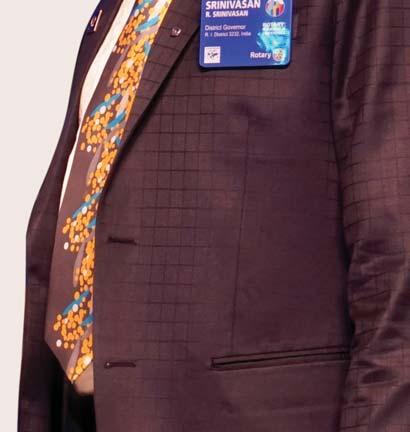


B M Sivarraj
Steel Manufacturer
RC Thane Northend, D 3142
He joined Rotary in 1999 and has been a “hard core Rotarian since then.” DG B M Sivarraj is happy that Rotary projects such as the Jaipur foot, midday meals for schoolchildren and check dams have enhanced people’s lives in his region. “While RI President Ian Riseley wanted the 1.2 million Rotarians to plant as many saplings world over, we have planted 1.45 million saplings across Maharashtra,” he says, adding that the district has signed an MoU with the State government to plant 5 million saplings in the next two years. Tribal families around Palghar will have a steady income as he has signed an agreement with NABARD to grow fruit-bearing trees in their 500 acres of land.
“Rotary is vibrant here though ours is a fairly new district,” he says, listing out the year’s developments — a membership increase of 500 with six new clubs chartered and 25 clubs with less than 20 members revamped to form 20 clubs. “We may give the Convention a miss, although we have registered for it, as we will be working in a frenzy for TRF collections. The district target is $1 million but I am sure we will be able to collect $3 million,” he smiles with confidence. He is happy that Rotaract is active in the district and Rotarians are funding their projects.
Sivarraj is focusing on a global grant, involving all 83 clubs, to provide e-learning and promote menstrual hygiene in 400 schools. Addressing thalassaemia is also on his agenda. “It’s my aim to see that the district does not report any new case in the next three years.” He is all excited about a sanitary napkin making unit the district is working on with corporate funding. “The price of each napkin will be less than ` 2 but the quality will be in compliance with the WHO standards. We want more women to benefit from this initiative,” he says.
He is a Level IV Major Donor. His wife Manonmani is the charter secretary of the Inner Wheel Club of Thane Northend; his son is a Rotaractor and daughter, an Interactor.

Ajay Agarwal, Mining, RC Bhadrak Midtown,
“I grew up experiencing the Rotary spirit right from my childhood,” says Ajay Agarwal. His parents are Paul Harris Fellows and Rotarians of RC Bhadrak. He has won the Best Rotaract President award from the then DG Lalit Surjan in 1993 and became a Rotarian in 1997. “As a Rotaractor, I have participated in several polio immunisation camps, visiting remote, inaccessible areas on my bike or in boats. Rotarians used to send us to reach out to people there. As Rotary president in 2001, I can never forget the Hepatitis B vaccine my club administered to 28,000 children. It was a record then,” he beams.
He has been promoting service projects that include a cancer screening van to tour rural and backward areas and refer critically ill patients to the Apollo Hospital and the Konark Critical Care Foundation in Mumbai with whom the district has signed an MoU; five dialysis centres set up in Bhadrak, Joda, Berhampur, Bhubaneshwar and Cuttack; and 15 Saheli centres that impart training in computers, accountancy and sewing to women across the district. He is all excited about the organ donation campaign to be held in April when he hopes to create a world record with the participation of Rotaractors.
Agarwal is satisfied that his TRF collections is on track with $100,000 in the kitty against a target of $500,000 which he is confident of achieving. “There will be few Major Donors too,” he says.
He is focusing on retaining members by inspiring them with good service opportunities and is planning a 10 per cent membership growth. “I have encouraged women members with appointment in significant district posts.” Ritu, his wife, is a member of RC Bhubaneswar New Horizons and a past president of the Inner Wheel club. Both of them are Major Donors.






The most important lesson
Nancy Sharma, one of the 150 students who participated in the RYLA conducted by RC Faridkot, D 3090, learnt at the three-day programme was “never let people tell you that you cannot do something, or you can never achieve anything.” Dubbed Umang (Hope), the aim of this RYLA was “not just about rest and recreation. It was to create awareness about Rotary among the youth and inculcate in them leadership qualities through self-improvement,” says RYLA Chair Devinder Singh.
DG Bagh Singh Pannu inaugurated the RYLA, along with MLA S Kushaldeep Singh Dhillon, and Rajiv Prashar, IAS Deputy Commissioner, Faridkot. The programme was also aired on the local TV channels,
enhancing Rotary’s public image. “ Umang has helped these students imbibe a feeling of social service and also helped them understand Rotary in a better way,” says DG Pannu.
“I wasn’t aware I could be a leader,” says Nancy but the “Rotarians made us realise that we do not have to be in great positions or spend a lot of money to create an impact. All you need is a smile and the intention to do good.” On what she learnt at the RYLA, Sapna, another participant, says, “At the end of the day, it’s not about who is smarter or who is brighter, it’s about the collective goal to improve your community.”
Apart from celebrating Lohri, at the Radha Krishan Dham orphanage and rendering service at a home for the mentally challenged run by the
Red Cross Society, the students were trained in yoga, briefed on organ donation and participated in interactive sessions on women empowerment and the ill-effects of tobacco. They were also treated to a Bollywood night and given a chance to perform on stage. “Be it singing, dancing, Bhangra, histrionics, mimicry or poetry recitation, the students gave fantastic performances,” adds Singh. Outdoor activities covered visits to a rice mill, shooting range and an open-air cookery class.
For Manu Singh, a RYLA participant, his main goal after going back home, “is to start doing better in school and take up challenges to improve myself. I have learnt so much at this RYLA and I want to be a part of this event every time it is being held,” he says.
Columbus discovered USA and since then it has become a land of opportunities for many. This mystic land is also the world’s largest tourist destination. The most popular tourist destinations in the US are of course the magical Disneyland, Universal Studios, the Grand Canyon, Las Vegas, San Francisco and New York.
But in 2008 when I went for a month-long expedition as a Rotary Group Study Exchange team leader to Ohio State, I was mesmerised by the Midwest. We stayed with local families, visited several unseen places and met many interesting people. We had a local Rotarian as a guide/mentor and learnt a lot about vocations, culture, dining as well as fashion and etiquette.
One fine day, after a breakfast Rotary meeting at Mansfield, our host volunteered to take us to visit a bicycle museum nearby. Initially I was not very keen; what is there to see in bicycles was my natural reaction. But when he told me that this museum has the largest private collection of bicycles in the
world, I got curious and interested.
Bicycles were not just playthings or toys for the rich. Throughout history they were used for commercial purposes ranging from delivering messages
and parcels, to being used as hired transportation and carrying policemen on patrol. They also saw military service during World War I.
According to the curator at the museum, Jim
Dicke, founder of Crown Equipment, during a meeting, asked his colleagues, “What could we do to bring people to this small town of New England; make it more liveable and a tourist destination?”
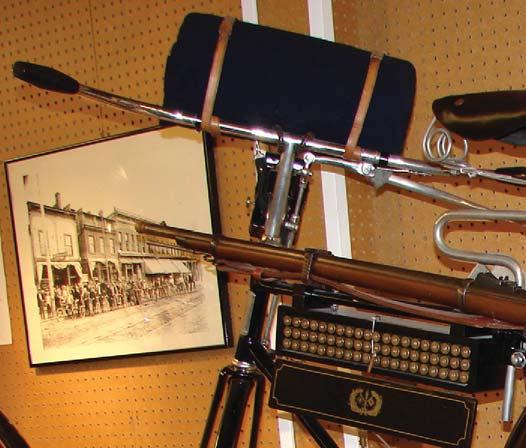




With this thought in mind, he bought Schwinn’s private collection when they went out of business in the 1990s. The Schwinn collection — and many more bikes since then — is now kept at the Bicycle Museum of America in New Bremen.
The collection is housed in a beautiful old gingerbread storefront, and visitors to the museum are greeted with friendly staff eager to share the stories of the hundreds of bicycles on display. The visit begins


with a short video on the museum and the different types of bicycles included in the collection. From there, visitors can explore two floors of beautiful bicycles and see hundreds of examples of antique bicycle club badges, bicycle safety equipment and bikes that will both delight and amaze.
The museum houses elegant antique bicycles from the 19th century, balloon tyre classics of the 1940s and 1950s and even the banana seat high-rise handle bar bikes of the 1960s. It proudly houses the world’s largest high-wheeled bike. This museum has on display over 300 bicycles and contains over 1,000 in its collection. Here you will see everything from primitive bikes with appropriate names like the Boneshaker, high-wheeled bicycles that the older generation enjoyed, to modern carbon frame bicycles that one can lift with a single finger.
Here you will find everything from wooden bikes and Harley bicycles to unicycles. It’s just a small little place, but packed with so much entertainment and information! There are bikes here one can ride, bikes you can touch and videos you can watch. If you are a museum lover who loves to amass information, then you’ll get plenty to read, plenty to ogle and laugh at (not every bike invention was a success). We finished our tour in two hours, but avid two-wheeler fans can spend
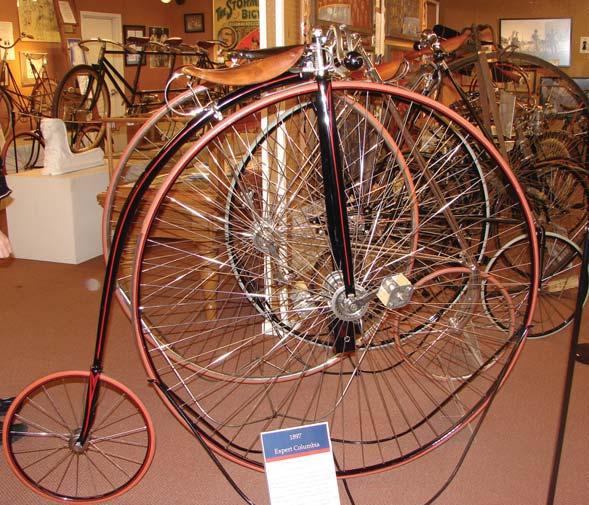
an entire day here. The curator-cum-guide at this place is very helpful and has many stories to tell.
Bicycle racing has been a popular sport ever since the first rider climbed on board and challenged the next guy to come along, and the museum’s racing bicycles range from an 1898 Wright Brothers St Claire that Wilbur Wright won many medals with, to the 2004 Trek Madone SL that helped Lance Armstrong win his sixth Tour de France victory.
The oldest bicycle in the collection is an 1816 Draissine, which consisted of two wooden wheels connected to a wooden beam. The rider straddled the beam and propelled himself with his feet against the ground, steering with the front wheel while leaning his forearms on an upholstered balancing board to maintain equilibrium. A brake on the rear wheel could be activated by

pulling a leather cord attached to the balancing board. The Drassine was more a nobleman’s folly than a serious mode of transportation, but it was one of a long line of inventions that eventually led to the modern bicycle.
But the most prominent amongst this collection is a bicycle with a 64-inch front wheel. This bicycle has appeared in the Guinness Book of World Records as the world’s largest bicycle.
The Bicycle Museum of America is located at 7 West Monroe Street in New Bremen and is open Monday through Friday from 11 am to 5 pm and Saturday from 11 am to 2 pm.
More information on the museum is available on http://www.bicyclemuseum. com
The writer is a PDG from RID 3131. Designed by Krishnapratheesh

Bharat and Shalan Savur
Are we capable of self-healing? A thousand times yes! For research is piling up to show that the mind is a powerful healer. The Master has always said, “By right, wise and powerful thoughts, by maintaining equanimity of your mind, you can raise the sinking ship — your body — and tow it back to the glorious shores of health.” Now, medical science estimates that at least 90 per cent of physical ailments stem from emotional upheavals. And when we continuously send healing messages to the brain via visualisation and affirmation, these soothing images and meaningful words are translated into biochemistry, the language the body understands and responds to.
an ‘unconscious dependencywish that’s being thwarted’ and triggers asthma.


Bio-listening. The bio-listener is the immune system. When it continually hears distress, it begins to over-react. It mistakes normal, everyday stuff like wheat, dust, pollen as ‘enemy antigens’ and its white blood cells, the defending army that fights off disease, slews out antibodies — Immunoglobin E (IgE). The IgE can camp in the cells of any part of you body. If in the skin, we get hives; in the nose and lungs, we contract bronchitis or asthma; in the stomach, it could result in gastroenteritis. What is this distress that the immune system hears and overreacts to?
· Say, we’ve lost a dear one… it hears intense sadness as ‘suppressed sobbing’ and the skin erupts with hives, psoriasis, lichen planus.
· If we’ve been forced by circumstances to live an independent fending-for-oneself life, it hears the desolation as
· If we are tense with an overbearing parent or spouse, it hears and feels the constant tightness as an ‘over-anxiousness to please’, to live up to that person’s expectations and prevents natural development and causes stomach problems — ulcers, irritable bowel syndrome, diverticulitis. Simply put: when the immune system weakens, the body reacts adversely to food, chemicals even particles in the air and is diagnosed as an allergy.

ulcers, irritable bowel syndromee, diverticulitis. put: when the immune e system weakkens, the reacts to food, chhemmiccals even in the air and is d as an
Healing words. At the outset, therefore, it is imperative to strengthen the mind and immunity system with healing words uttered daily. I suggest a beautiful selfhealer: “I enlighten what is dark in me. I strengthen what is weak in me. I mend what is broken in me. I heal what is sick in me. I invoke all the peace and love banked in me and fill me with their fragrance. All powerful, positive, healing energies are
positive, energies are working in i me. I thank all the positive e fo f rces of good o health for continually su s pp p orting me.”

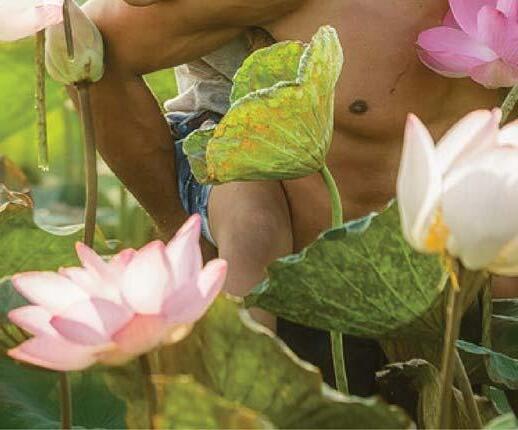



asthma. As time passes and the suppressed inner grief dissipates, the skin begins to clear.
d if you ve grown up and left behind s some ado d lescent In thi s g prococesss, the mind change b is more relaxed, more ac a cepting g ab a s giiving up allergyy provoking g food d k or underea e t tiing so o as not to o pr p ovok o
Using self-healing words is a worthwhile psychological approach. It literally takes advantage of how the mind can influence the body: a beautifully strengthening message is sent from the brain to the rest of the body, putting you in a stronger, healthier biological state. Healing words uttered daily essentially transform our mental attitude from vulnerability to virtual invincibility. This attitude, say allergy experts, can actually lower the body’s levels of histamines and other allergy-promoting chemicals. It’s a gradual fade-off. The allergy, the asthma decreases in intensity and frequency. It bothers you less and poof! One day, it’s gone. It’s as if you’ve grown up and left behind some adolescent affliction! In this healing process, the mind changes. It is more relaxed, more accepting about giving up allergy-provoking foods or undereating so as not to provoke

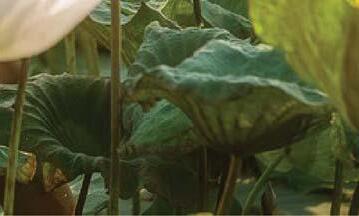
Avoid stress. A person with asthma needs to always carry an inhaler (a spray-pump) with her as there is always pollution hanging in the air. When breathlessness strikes, it can be frightening not to be able to draw enough air in and a reaction of panic and fear can set in and worsen the attack. The inhaler gives relief almost immediately. An asthmatic should avoid stress as well as any situation that could bring on panic. Healing words, relaxation techniques including meditation, leisurely walks in the park and breathing exercises help greatly. Get enough sleep. Lie in bed and tighten your body, every part of it. Then release and make it relax. This is how you train the body to relax and then allow it to drift into deep sleep.
The Kabbalah, a branch of Judaism, has a beautiful teaching about how we are all connected by a membrane of light. And when that clear stream of healing light is obstructed or constricted by anger, fear, hatred or grief, we get disconnected from the light and fall ill. When we let go these debilitating, egoistic emotions, it’s like opening a huge door and letting the sunlight in. The light streams into our minds, our bodies and our immunity levels rise and we become healthy again.
The connective key is complete acceptance of everybody and everything. To start with, please don’t be so quick to judge adversely. Train the mind to be non-judgmental. And hence:
First, sow the seed of good intentions. Think, “From now until I die, I will be very careful not to allow disturbing emotions to rise.” This is the best mind-insurance policy we can subscribe to.
Second, preserve and enhance this intention by constantly mellowing your thoughts. If you criticise,
as instantly take it back and infuse understanding. Remember two things vividly: Each one is right, no one is wrong. There are always mitigating circumstances. The anecdote of the great Italian poet Tasso’s beautiful intention never fails to move me: When asked why he did not take revenge on a man who had harmed him grievously, the poet replied thoughtfully, “I do not desire to harm him, yet there is one thing I would like to take from him.”
“You want to take away his honour or wealth?” Tasso was asked. He said gently, “No. What I desire to take from him with kindness and patience is his ill-will.” What an intention!
Third, eliminate the self-centred attitude that every situation, every person must work your way, for your benefit, on your say-so. Functioning from a ‘my terms and conditions’ attitude is an obstruction to that membrane of clear healing light which connects all of us. The ‘my’ separates, isolates and obstructs us from the light, causing anger and other negative emotions. Contemplate this self-inflicted harm and resolve never to let it sway you from the great quality of accepting all that is.
Fourth, continually acquaint your mind with the practice of acceptance and maintain the intention for doing so. Everything becomes easier with acquaintance. The mind can be a good student. From self-control, it’s only one more step to self-healing. Continue on this glorious path of endless light. The Master says, “Your effort should be like the flow of a stream — sustained, continuous, balanced.” Let joy fill your mind, ease fill your body, and bliss your being. Your immune system will rejoice in great wellbeing.
The writers are authors of the book Fitness for Life and teachers of the Fitness for Life programme.
Designed by Krishnapratheesh




In January every year, book lovers converge in the pink city for the ‘Zee Jaipur Literature Festival’ (JLF). People browse through a remarkable collection of books and also listen to and interact with celebrity authors/writers over five days of debates,
lectures and discussions.
A huge attraction is of course the eclectic bouquet of live music at the famous heritage sites such as the Amer Fort and Hawa Mahal.
This year, over 300 national and international thinkers, writers, including

Nobel laureates and Man Booker prize winners graced the 11th edition of the JLF held in the majestic ambience of Diggi Palace, decked up in Rajasthani royal décor.
The inaugural session had Meeta Pandit and Nathulal Solanki
A unique feature of JLF this year was sessions on feminism and women’s rights.
mesmerising the crowd with their native music and dance performances. The jam-packed front lawn on Day 1 saw a young poet Rupi Kaur perform and recite her heart-touching poems in the session Milk and Honey bringing tears to the eyes of the listeners. Other parallel sessions included Sir Tom Stoppard in conversation with theatre personality Sanjna Kapoor; and book launches of The Maitreya Chronicles and The Golden Dakini, authored by Charu Singh.
A unique feature of JLF this year was sessions on feminism and women’s rights. People flocked to listen to noted politician Margaret Alva in her session Women and Power. She shared the session with Helena Kennedy, a British barrister and Labour

MP and journalist Arati Jerath was the moderator. They discussed issues such as gender equity, women’s position in society, etc and unanimously agreed that women are harassed universally and the ultimate challenge for them is to break the administrative hierarchy which is male-dominated. In the session, Visible Work: Invisible Women, important questions on
women at the workforce were raised.
All five evenings saw a cocktail of genres and styles that included Rajasthani folk music sprinkled with Sufi and Bollywood mix, jazz and other performances.
the launch of his poetry book, Nude: The Poet Within, and reflected on the challenges of adapting Shakespearean plays into film. In another
freewheeling session, he took the audience on a personal journey of love, denial and self-discovery. Veteran actress Sharmila Tagore and
The panelists unanimously agreed that women are harassed universally and the ultimate challenge for them is to break the male-dominated administrative hierarchy.
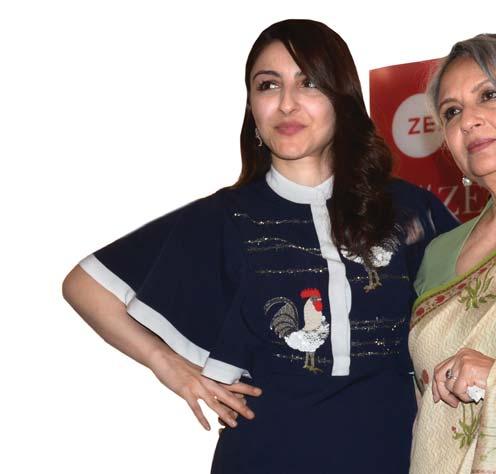
In his session The Great Survivor, Hamid Karzai, former President of Afghanistan, shared his perspectives on his country and its relations with India. A session by journalist Victor Mallet discussed the relevance of the Ganga River to India’s future and prosperity, while the session Why we must protect the Aravallis, focused attention on the crucial need to protect these hill ranges.
Filmmaker Vishal Bhardwaj discussed


daughter Soha Ali Khan Pataudi made a joint appearance for Soha’s recent book The Perils of Being Moderately Famous. MP Shashi Tharoor touched on a range of subjects like fiction and nonfiction writing and the difference between Hinduism and Hindutva across various sessions.
Seasoned writers including Hugh Thomson, Pico Iyer, Raja Shehadeh, Redmond O’Hanlon, Bee Rowlatt and Robert Dessaix related their unique travel experiences. Lyricist and Central Board of Film Certification chief Prasoon Joshi, along with a few other celebrities like poet Javed Akhtar, Shabana Azmi, who are regular contributors to the JLF, missed the fest due to the Padmaavat controversy this year.

The concluding day at JLF saw an intense and powerful debate on Me too: Do Men still have it too easy, based on atrocities against women and leadership of women. The panelists argued that across the

globe, men find it easy to exploit and harass women. The session brought out that worldwide only 10 per cent leaders are women while in India it is merely 3 per cent.
Speaking in the session, The Dance of Democracy, politician Sachin Pilot made a debatable proposition that only politicians, and not people, can reform the system and empower the citizens.
British journalist Matt Frei, author of Only in America and maker of a documentary called The Trumps: From Immigrant to President, explained the Trump phenomenon and what it means for American and world politics. Sessions featuring Amy Tan, Pico Iyer, Hamid Karzai, Zakir Hussain, Salman Khurshid, Chetan Bhagat, Sonal Mansingh, Suki Kim, Micheal Ondatjee, Mira Nair and Helen
The session brought out that worldwide only 10 per cent leaders are women while in India it is merely 3 per cent.
Fielding, among others, were all well-attended.
With the growing popularity of JLF every year the number of international and national visitors is increasing enormously. This year, a record half a million footfalls, higher by around 23 per cent over last year, were recorded.
A crowd puller of the event, however, was the tea-sellers dressed in traditional safa and dhoti-kurta dishing out tea in kulhads (clay cups).
Pictures by Anubha Agarwal
Designed by Krishnapratheesh

V Muthukumaran
Rotary
Club of Palai, D 3211, promoted religious harmony through a unique blood donation camp. A Hindu thantri, Christian priest and an imam set the tone for the camp and they were followed by 15 other people. “As our blood bank does not have a large storage and some blood groups have limited gestation period, we are constrained to accept donations from limited number of people at a time,” says Dr Tessy Kurian, who is the first woman president of the 32-year-old club. “We are bound by the chords of love, peace and harmony because we are united by the same blood. This is the message we wanted to highlight through this blood donation camp,” she says.
The club, with its team of 117 members, is one of the largest clubs of the district and it also includes 31 women Rotarians. Apart from the blood bank, the club has a dialysis unit which treats six people at a time.

“We have donated a bus to a deaf and dumb school and run a trauma-care van to transport accident victims from the incident spot to nearby hospitals,” says Tessy.
A modern kitchen and a water treatment plant were installed at Maria Sadanam, a home for the differentlyabled, which has 350 inmates. “During
birthdays, wedding anniversaries and celebrations, we sponsor food for the inmates.” Under HOPE, their signature project, the club has set up a paediatric ward costing ` 15 lakh at Maria Sadanam. The club has performed over 1,000 cataract surgeries worth `1 crore which had benefitted mostly the elderly in the community.

Eminentacademicians and social activists were the facilitators at the one-day teacher training programme organised for the first time by RC Katwa, D 3240. The workshop was attended by 70 primary school teachers.
PDG Swapan Chowdhury; AG Pallavi Maji; trainers Bodhirupa Sinha, Principal, Viswavarati Santiniketan University; Manisha Banerjee, headmistress, Labpur High School; Puspen Chattapadhyay, child rights activist and BDO; Subrata Mukherjee from District Land and Land Reforms Office, Murshidabad; and Janbas Shaikh, Sub-Inspector of Schools, Nabadwip North, made presentations on various aspects of teaching and ways to inculcate children’s interest to learn.
Subrata Sain, the club’s Literacy Committee Chair, handed over the certificates, signed by DLCC Bibhas Purakayastha, to the participants.

Atoilet block at Government Girls Higher Secondary School in Mecheri, a village near Salem, was inaugurated at a cost of `4.25 lakh. It had a global grant funding from TRF and RC Danville/Sycamore Valley, D 5160.

The club organised a meditation camp for schools in which 1,500 children took part with enthusiasm. The Rotarians distributed 600 notebooks to the school children as part of their Happy School project.

Pongal was celebrated at Kalaimahal Nursery and Primary School in a traditional manner. Games were organised and over 200 students took part in the event. Sugarcane and sweet Pongal were distributed to them. Over 30 Rotarians were present on the occasion.
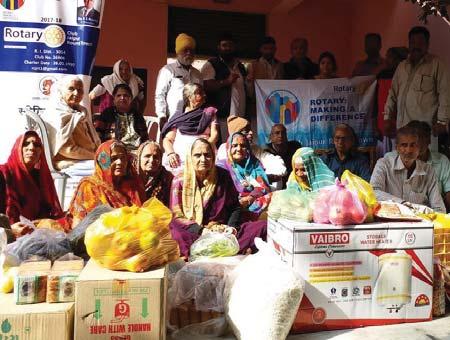
Groceries were donated to Shri Ram Vridh Ashram, an old age home, at Chaksu village near Jaipur by the club members. The inmates thanked Rotarians for their thoughtful gesture.
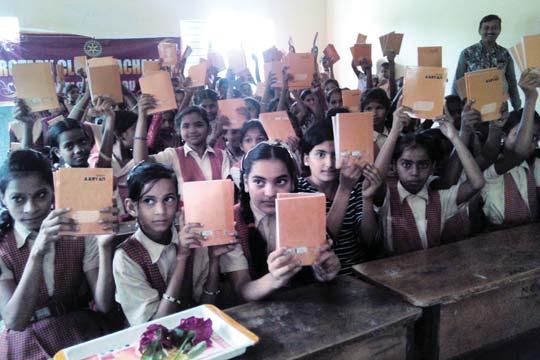
RC Surat Roundtown — D 3060
Afriendship exchange team from Mexico visited the Mamta School for Special Children in Surat. The children entertained the visitors by staging programmes. The club is supporting the school with food, donations and other play and learning equipment.

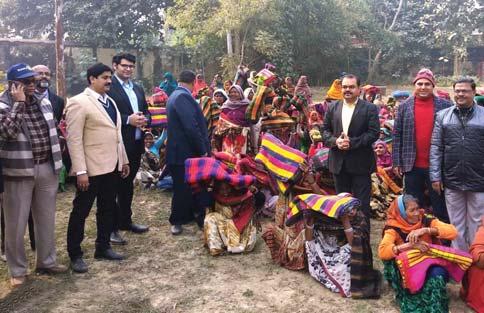
InVaranasi East — D 3120
association with Hotel Hindustan International, the club distributed blankets and clothes for the needy in Sarnath and nearby villages. Club President Chanchal Kumar Ganguly coordinated the project with the hotel executives who had assured that they would extend support to the club for such humanitarian projects.
RC Jammu Midtown — D 3070
Amedical camp with focus on dental and oral hygiene was held at Naveen High School in which over 450 students were screened by a team of dentists and Rotaractors from a medical college.

Shahjahanpur — D 3110
Adental camp was organised for differently-abled children at Mata Asharfi Devi School. Free toothpaste and Ludo game boards were distributed to the children.

Athree-day workshop titled Tarunyabhan was held by gynaecologist and social worker Dr Rani Bang and her team at MIT polytechnic in Kothrud. Nearly 800 teenagers listened to a wide range of topics covering physical, emotional trauma, sexuality, choosing life partner, matrimonial life and other family issues.

RC Ahmednagar
Priyadarshini — D 3132
Under Project Vyakti Vikas, the club joined hands with other clubs in the region to organise psychometric tests to evaluate the personality and psychological quotient of children in their Interact clubs. In all, 600 interactors benefitted from the project.

Economist and tax expert Homi Ranina gave a threadbare analysis of the Union Budget 2018 at a joint meeting of the club with RC Mumbai Nova. Listing out the salient features of the Budget in his inimitable style, he was heard in rapt attention by a distinguished audience of Rotarians and invited guests.

Stationery, pouches, hand wash and first aid kits were distributed to students of a primary school in Pamulamitta village, Tada mandal. Over 40 students benefitted from the project sponsored by Rtn V Vijayalakshmi who had spent `5,000 to purchase the donated items.

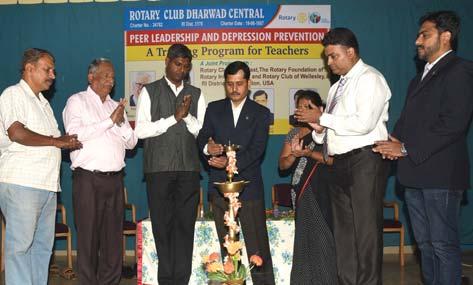
Atwo-day workshop for teachers on Peer Leadership and Depression Prevention was held at the KLE RLS School. The event was part of a global grant project taken up by RC Hubli East, in partnership with RC Wellesley, Boston. Over 40 teachers took part in the workshop.

Amusical night was held as a fundraiser and its proceeds of `3.25 lakh was donated to the families of 20 cancer patients and a homeless widow. The musical, inaugurated by Kuttiady legislator Abdulla Parakkal, had participation from about 680 people.
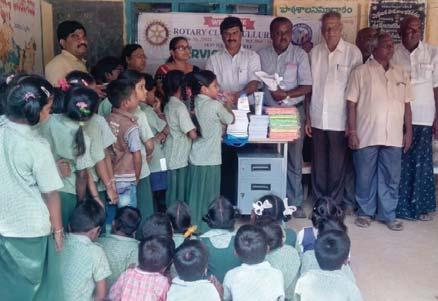

Apublic toilet run by the club at a private bus terminus was renovated at a cost of ` 7 lakh. An exclusive ‘wash and change’ room was set up for tourists at the top floor of the building.

Chairs and dustbins were donated to the government hospital in the town. The Chief Medical Officer appreciated the club’s contribution. The project cost `22,000.

An eye camp was held at the Panchayat Union Middle School in Pallikuppam, in association with the Christian Medical College, Vellore. Around 250 students were screened for various eye disorders. Spectacles worth `20,000 were delivered at the camp.

AGuinnessattempt was made by the club in holding the longest lecture on ‘Drug abuse awareness and youth’. The talk was delivered by Dr Vengadesh Babu from the Indian Customs at the Jeppiar Engineering College and was attended by club members, Rotaractors, students and the faculty.
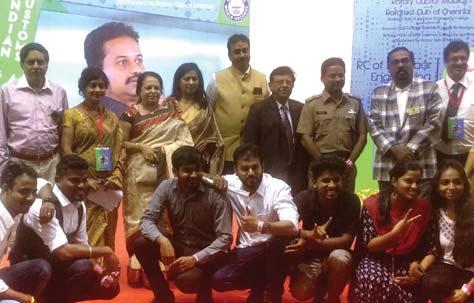
Amegahealth camp was organised at the Rajatota village in Jajpur district. Specialists from hospitals in Cuttack, Bhubaneswar, Visakhapatnam and Mumbai diagnosed and treated over 2,600 patients.
Compiled by V Muthukumaran
Designed by L Gunasekaran
Seventy-two-yearold Jagbandhu Singh is both happy and sad. He feels dejected that puppetry has lost its shine in the glamourous world of television and social media, even as he remembers the heydays of the glorious traditional art when he was flooded with shows and hardly had time to spare. He is saddened that many artists sat idle without work for months, finding it difficult
to arrange even one square meal a day.
But his eyes light up with hope as he realises that slowly puppetry is gaining recognition due to the efforts of the West Bengal government and social enterprises who are extending patronage to the art.

Jagbandhu resides in Muragacha Colony in West Bengal’s Nadia district, the birthplace of puppetry art in the State. After the partition of India and Pakistan in 1947, most of
the puppeteers relocated to villages in Nadia district.
“Our ancestors had moved from Pakistan after independence. Puppetry used to be their livelihood there and they continued the vocation when they arrived here too,” he says, relating the history told by his parents.
Puppetry in West Bengal, which finds mention in the medieval folk ballads of undivided Bengal, is commonly called putul naach (doll dance). Traditional forms of the art include rod and glove puppets. String puppetry, which is nowadays in practice, was a later
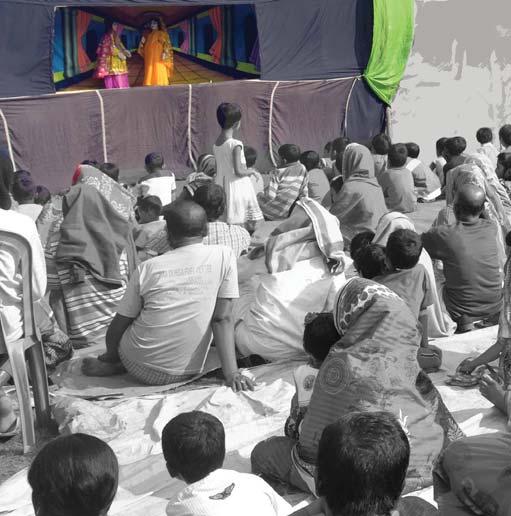
import, says Jagbandhu. String puppets, originally manipulated with string and also with wire, are mostly found in Nadia.
Until two decades ago, almost every household in Muragacha was involved in puppetry, ranging from making puppets to giving performances. But the advent of television, coupled with the waning interest of people, rang the virtual death bell for the art.

“There were around 380 families in the village that were involved in puppetry in the 1980s. The artists were in great demand and spent around six months every year outside the village giving


performances across the State and even outside. We normally performed at least 25–30 shows every month. The income was also good and we didn’t have to look for any alternative forms of livelihood,” says Amolya Rai, a puppetry artist.
But things began to change from mid-1990s when other forms of entertainment emerged both in urban and rural belts of the State., “We started losing work as people began to switch to television. The cable network proved to be the last nail in the coffin. People lost interest in puppetry despite the fact that it was devoid of vulgarity and always gave a social message to the children,” he added.
Now, most of the puppeteers are working as labourers; some have even migrated to other States, looking for alternate livelihood.
However, the State government is taking efforts to revive the dying art. A series of shows were held during the winter months and Bangla Natok, a social enterprise has been actively supporting the artists to conduct shows in other cities and villages.
Ranjan Rai, another artist, says that children
We also perform shows based on themes such as adhering to traffic rules, importance of wearing helmets, literacy etc.
We started losing work as people began to switch to television. The cable network proved to be the last nail in the coffin.
in cities are interested in watching the puppet shows as “they have never seen anything like this before. We are also shortening the duration of the shows to keep the interest alive.”
Some modern adaptations are also being made to mythological stories such as the Ramayana, Mahabharata and Panchatantra Tales, to sensitise people on various social issues. “We also perform shows based on themes such as adhering to traffic rules, importance of wearing helmets, literacy etc,” he added.
Amitava Bhattacharya, the founder of Bangla Natok, says that puppetry
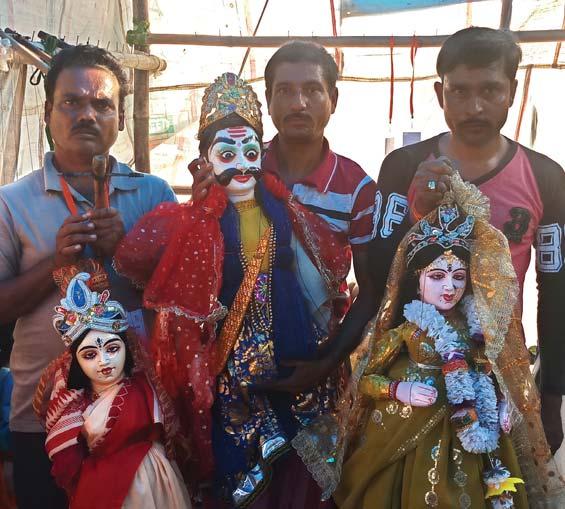
has a great scope and wider reach among everybody, especially children. “We started working with puppeteers about two years ago and have conducted workshops with about 80 artists and then linked them to various festivals.” At least 30 of them have visited few cities outside Bengal, two artists had performed at the Gannat Festival in France in 2015. Puppet shows were held in various places during
Durga Puja and in school programmes. “We, along with the State government, are also conducting a three-day puppetry fair every year in December to promote the art. It has helped us to attract the younger generation.” It is time to revive the culture which has been slowly getting lost in the noise of technology and modernisation.
Designed by Krishnapratheesh


There was once a finance minister, from non-South Indian State I might add, who used to call me Mr Alphabet because of the length of my name. His own name was a poverty-stricken two-word thing. Worse, both words were of two syllables. But I shan’t be churlish because he was right. My name is simply too long, all of 49 letters. In my first year at college, much of the ragging I underwent consisted of having to repeat my name forwards, backwards, spelling and permutations of the five words.
That doesn’t mean it doesn’t have its advantages, few and far between though they might be. For example, at immigration at Delhi airport one officer once told me he was thrilled to see me. Since I had never met him before, and nor was I a Bollywood or sports celebrity, I asked why. He said when he tapped my name into the computer, only around 18 other names popped up unlike, say, if your name was some two-word abomination like, well, Ashok Mitra.
The officer then asked me if all those people on his screen were related to me. I said probably, and he said it was a pleasure to clear me through as he didn’t have to scroll through 10,000 Suresh Kohlis or 5,000 Virat Rainas. “ Phataphat ho gaya, Sir, aap ka case ” he beamed.
I can understand his happiness. Immigration officers spend 6–8 hours staring at screens peering at names. Short names like Anand Desai appear in their thousands and after that he has to match them to the passport number. Can you imagine any drearier job than this? No wonder when a Tirumalai Cunnavam Anandanpillai pops up, his eyes light up. Add Srinivasa Raghavan and, oh joy! There is only one name left on the list.
But so far, I must confess, that is the only advantage that I have come across. One problem is that since everyone in the family has chosen to shorten the initials to TCA, people think we are perfectly fungible. But now that the fourth generation has arrived, you can imagine how annoying that is. “Are you the TCA who writes for The Hindu ,” I am asked. “No, Sir”, I say about five times a month, “that is my son”. No, no, they say, he looks very old in the photo. “Oh, him”, I reply, “that’s my uncle.” I shudder to think what will happen when the fifth generation turns up.
It doesn’t stop there. I don’t know when — or why — but the Iyengar community seems to have decided that it will offer a choice of around 12 names only, which can then be placed in any combination. Thus we have Srinivasan, Ramanujam,
Varadan, Raghavan, Ranganathan, Rangachari, Krishnan and six or eight more. The main problem arises when two brothers — like my father and uncle — decide on the same, or nearly the same name. Thus my brother is Rangachari and my cousin is Ranganathan — which was also the name of my late brother-in-law. Another brother-in-law is called Varadakrishnan. How inventive can you be?
But without any question, another cousin and I are the worst off: he is called Raghavan, and used to work for the government. Often during his career, he was hauled up by his superiors because I had written an article criticising it. Poor fellow had to keep explaining it wasn’t him. But the boot is now squarely on the other foot. In recent times, he has become a very famous writer and I keep getting invited to speak and dine — not to mention the fat cheques for articles that he writes. One of these days I am going to accept the speaking and dining invitations just to see the look on the organisers’ faces!
A hospital in France has introduced mini cars for child-patients to drive to the operation theatre for surgery. The doctors came up with this idea to help children overcome fear and anxiety and eliminate the usage of anti-anxiety medication before the procedure. The car will be steered and remotecontrolled by the medical staff. Similar programmes have already been introduced in the US and Australia.


The Bilal Masjid on Grant Road in Mumbai serves vegetarian food for the poor through a specially established Langar-e-Rasool (Prophet’s Kitchen). Every night, just before the prayers, devout Muslims distribute food packets, each containing three rotis, sabzi and pickle, to the needy assembled at the Idgah Maidan. The menu is intentionally kept vegetarian to benefit more people. The mosque has the capacity to distribute 400 such packets daily and several people from other communities too contribute generously for this service.
Often, we see motorists driving their two-wheelers on footpaths, trying to beat the traffic and endangering lives of pedestrians. Have we raised our voice against this atrocious practice? Here is Manju Thomas in Bengaluru who does object to it. She stands on the footpath, obstructing motorists and telling them to use the road instead. A video of Manju in action, uploaded on Facebook, attracted several ‘Likes’. It also showed two men get into an altercation with her, and end up riding on the road, with Manju being adamant on her stand.
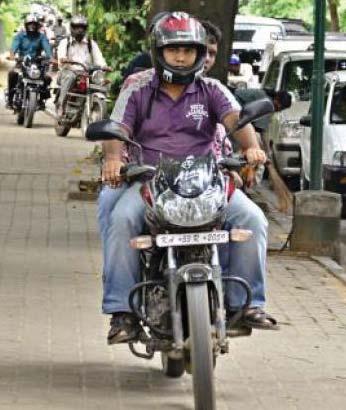
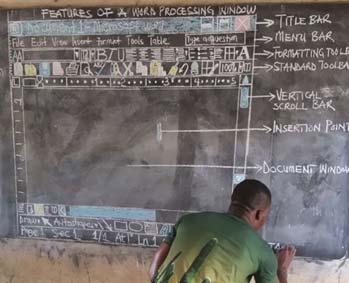

While ‘selfie-deaths’ on the railway tracks are becoming more common, the Railways have identified 70 designated locations for the ‘selfie-obsessed’ traveller and the work is expected to be completed by December. ‘Selfie-points’ top the list of amenities which include ATMs and mobile charging ports in the waiting hall, wheelchair assistance and volunteers. Five stations —– Udaipur, Jaipur, Bikaner, Jodhpur and Gandhinagar — in Rajasthan are included in this nationwide endeavour.
When a video of a Ghana teacher explaining MS Word on a blackboard to his students went viral on Facebook, NIIT reached out to him with five computers, a laptop and books for the school, through their local office in Ghana. Richard Appiah Akoto, the teacher, has been teaching IT to his students without a computer since 2011. He had neatly drawn and intricately designed the MS Word template on a blackboard to give an idea about this popular application to his students. This gesture has created a ripple effect with many others donating computers and other material to the school, while Microsoft Africa sponsored Richard’s trip to Singapore for the annual Microsoft Educators Exchange.
Regn. No. TN/CCN/360/2018-2020 Licensed to post without prepayment No.TN/PMG(CCR)/WPP-431/2018-2020
Registered with Registrar of News Papers for India 3880/57 Rotary News Published on 1st of every month
Total number of pages in this monthly issue, including cover, 84. Price: `35







When the Kissels, Heike and Dennis, met fellow German Rotarians (and former Rotaractors) Sandra Buehrke, Constanze Abendroth, and Lutz Olbrich during the 2013 Rotary International Convention in Lisbon, Portugal, something deeper than friendship was formed. A chance encounter at a House of Friendship booth featuring a bottle cap collection fundraiser led to dinner, where the idea sparked excited conversation to do the same at home.
Four years later, their group leads a successful nationwide effort for polio that has collected 150,000 kilograms of plastic bottle caps for recycling, providing funds for about as many polio vaccinations.



Find your inspiration at the Rotary Convention in Toronto. Register today at riconvention.org.

23-27 JUNE 2018
TORONTO, ONTARIO, CANADA
